Share
https://int-magazine.com/interview/slay-the-princesss-tony-howard-arias-and-abby-howard/
クリップボードにコピーしました

Interview #6 2025.09.29
“We are unknown, we knowers, ourselves to ourselves: this has its own good reason. We have never searched for ourselves—how should it then come to pass, that we should ever find ourselves?”
–On the Genealogy of Morality, by Friedrich Nietzsche, translated by Horase B. Samuel
Slay the Princess is a love story.
You can count on your fingers the components that comprise the game’s world:you. A princess. A path in the woods leading to a cabin and the basement within which she is held captive. The narrator’s voice telling you you’re here to slay her. If you don’t, it will be the end of the world.
Within the cabin is the blade. The player can decide whether to take it or not.
As you descend the stairs, you hear her voice. And in the depths, the princess in chains.

She may greet you. If she does, you can choose whether to say “Hi” back or “I’m here to slay you,” or you can remain silent as you approach.
In the most human-like ending of the first chapter, you fully ignore the narrator’s constant comments and escape outside with the princess. She says, “I’m cold. Is being happy supposed to be so cold?”
Then she is taken away by countless arms that appear from out of nowhere.
The world ends.
In the most animalistic ending of the first chapter, you fully obey the narrator’s persuasions and stab the princess to death without uttering a word. Her corpse stretches out on the cold ground. You leave the cabin, alone.
There is nothing there.
No cabin. No woods. No path. No world.
And you, too, cease to be.
In all cases, you find yourself once again on the forest path leading toward the cabin. The narrator repeats the same line like clockwork:
”You’re on a path in the woods.”
For practical reasons, allow me to add a disclaimer:
I am so enthralled with this game that the questions I asked its creators are motivated solely by my desire to understand it better. For that reason, you may not understand the answers provided by the creators without the knowledge you gain by playing this game.
I have edited our conversation to ensure that a general topic precedes everything as much as possible. However, readers who have yet to play the game may not be able to reliably follow things partway through the article. If that is the case, I advise you to purchase the game, play through to the end, and then return to this article.
In other words, for you as the player, this article will serve as your own cabin on the hill.
Now, let’s begin the interview.
Planning, Interviewer and Writer: Shohei Fujita
Interviewer: Daichi Saito
Photographer: Yuichi Yokota
Editor: Jini
English Translation: Caitlin Beggs Kojima
English Translation Review: Rie Ihara
“Human reason, in one sphere of its cognition, is called upon to consider questions, which it cannot decline, as they are presented by its own nature, but which it cannot answer, as they transcend every faculty of the mind.”
–The Critique of Pure Reason, preface to the first edition, by Immanuel Kant, translated by J. M. D. Meiklejohn
Interview participants:
Abby Howard, developer of Slay the Princess
Tony Howard-Arias, developer of Slay the Princess
Saito, editor-in-chief of I.N.T. and arranger of this interview
━━, interviewer and author of this article
(Voices and footsteps reverberate in a spacious room somewhere within the Tokyo metropolis. ━━ paces the floor with an uneasy expression on his face.
At last, Abby Howard and Tony Howard-Arias enter the room, led by Saito. With everyone gathered, they exchange greetings.)
(━━ pulls out a red letter from his bag and approaches the Howards.)
”I can finally see you, and you can finally see me.”
(As he says so, ━━ hands the letter to the Howards. The couple opens the envelope and pulls out the love letter from within: an English poem several lines long expressing love for Slay the Princess.)
(The couple, astonished, express their gratitude.)
Saito: (quietly to ━━ who has approached with reddened cheeks)
Good grief. You’re such a romanticist.
━━Oh, I’m so embarrassed. This is the first time in my life I’ve ever handed over a love letter.
Saito:
And that’s exactly why I had you come. But your face is bright red. Get a hold of yourself.
━━Yes, sir.
Saito:
…Alright. Let’s get started.
(Everyone takes a seat. The audio recording begins. Saito looks to the interpreter.)
Saito:
…Alright. Let’s get started.
(Everyone takes a seat. The audio recording begins. Saito looks to the interpreter.)
Saito:
Once again, welcome. Let’s start the interview.
The theme we decided on for this interview is love.
To discuss such a profound theme, it is important for us to first disclose who we are. Allow us to introduce ourselves.
(The attending interpreter makes a tasteful translation: “To start love, we first must get to know each other.” Saito and ━━ introduce themselves for a few minutes. The Howards nod as they listen.)
━━ (clearing his throat) Please introduce yourselves to our readers.
Abby: (looking at Tony)
……Do you want to go first?
Tony:(nods)
Sure. I’ll go.

I’m Tony Howard-Arias, the lead writer and game designer of Slay the Princess. Before I started making video games, I also worked at a newspaper and then a tech company.
━━ (hastily) What kind of jobs were those?
Tony:
At the tech company, I made tools to manage activities for non-profit volunteer organizations. Non-profit [work] doesn’t make money, so the company went out of business. Before that, I was a data analyst for Boston Globe (a major newspaper company in the United States). Neither job was as fun as [making] video games.
(━━ looks at Abby.)

Abby:
I’m Abby Howard, and I’m married to him. I…originally majored in science, but I switched gears when I was around twenty years old and became a graphic novelist.
━━ (hastily) Switched gears, huh? Why?
Abby:
Neither science nor drawing are very lucrative, so I thought I should do what I really wanted. From then, I published about seven books, met Tony, and started making games. I was in charge of the writing and graphics for Slay the Princess.
━━I read somewhere that the two of you met at a TRPG session. Even though you’re from different fields, did you both share a love of games?
Tony:
Yeah. I had already been a TRPG game master when I was in college.
━━I see… Uh. (looking down at the notes he brought) Your studio’s first work was Scarlet Hollow, [a game] in episode format still in development with two episodes released thus far. I read somewhere that the idea for that work came to you while on your way back from the New York Comic Con. I also read that at the time you two had yet to decide on what to do next with your lives.
Tony:
That’s right.
━━However, making games takes a tremendous amount of time and labor. How did you manage to pay the bills?
Abby:
Cat plushies. That’s what I did.
━━Pardon?
Abby:
Cat plushies.
━━…Huh?
Abby:
Well, uh, I made plushies of my pet cat and sold them. I used to draw an autobiographical comic, and my cat made the occasional appearance in it. Everyone liked her, so that’s how we earned the money to do Scarlet Hollow.
━━Oh, I see.
Tony:
She had several successful Kickstarters previously. We thought we could pull it off.
━━Speaking of which, Abby received an award in 2013 for the webcomic The Last Halloween. You were around 20 years old at the time, right? I read it, and it’s not the sort of work you can complete in a short amount of time. I can tell you’ve worked as an artist for a long time.
Abby:
Yeah. [I asked] what do I have to do to make money? When, how much? What projects can I start with that money? That’s the planning we’ve done to somehow make it to this point.
Tony:
In my opinion, I think many indie game creators are too caught up in one of two mentalities that they actually need both of; either they follow trends and try to make something that will earn the most money, or they are so engrossed in their work that they can’t create a realistic plan. Ultimately, you have to take the middle path between these two styles.
━━(nods) But even if you take the middle path, you need the passion to take that path in the first place, otherwise the work is never created. When and how did that passion begin to burn within both of you?
Abby:
Hmm. I’ve never not had passion. I’ve always made something since I was at least six years old.
Saito: …That’s amazing.
Abby:
I made graphic novels when I was thirteen. I tried publishing them at the time, but…they weren’t any good. I made a lot of awful things.
Tony:
I’m the complete opposite of Abby. For a long time, I was unable to find any object to project my passion onto. In various workplaces, I was trying to blend in [where I didn’t belong] among the pros of the field.
Whatever the job, the first few months were fun. It was rewarding and felt significant. But…after two years go by, I had to quit because I realized that I was being crushed.
And so as I was going from workplace to workplace, I eventually remembered that I liked to write since I was a kid. I remembered that when I was in school, I began serving as a TRPG game master, making stories for the players and playing alongside them.
And then, finally, I thought, “What if I make my own games?” I can create my own business with friends and have it go under or whatever. Around the same time, Abby was at a loss for what to create next… And then, as I was being tossed about by the circumstances, I finally understood that this is what I want to do.
━━I see. So your experiences trying your hand as a game master and in various professions led to the multiple and comprehensive selection of choices in Slay the Princess.
Tony:
Maybe. I always make too many choices. Abby and I argue about that sometimes.
Abby:
Editing is important. If I left you to your own devices, you’d make the menu expandable.
Tony:
We should’ve had more [choices].
Abby: (giving a small sigh)
Sure. I’m always taking his choices away.
Tony: (looking to the interviewer)
…Well, to be honest, I think this is a UI thing. The text box in Scarlet Hollow is small, so we can’t display all the choices at once. So in Slay the Princess, we tried lining up the choices vertically on the side of the screen. Because of that, things look a little neater.
━━Right now, in the upper right corner of my field of vision, I see a lot of choices for what to ask you two next. Let me scroll and see…

Abby & Tony: (modest laughter)
━━I just remembered about the graphics in Slay the Princess. The style of expression is restricted to pencil art. I read somewhere that this was to cut down on the production time and to allow for more variety and that Abby was solely in charge of it all.
Abby:
Yes, that’s right.
━━(suddenly talking faster and faster) I believe that this restriction created extremely good results in terms of art as well. The reason being that the princess that appears in the game is ever-changing as she takes on many different forms. Even so, you get the sense that it’s the same princess. I think that’s because all the graphics are drawn by one person, Abby. In short, the production’s restrictions had a positive effect on the artwork.
Abby: (slightly bewildered)
…Yeah.
━━(shaking) …Umm.

Saito: (calmly) This style of graphics is deeply tied to the game’s theme. Was this intentional?
Abby:
Umm… Sorry. My drawing process is very hard to put into words.
…But I think what you’re saying is correct. In other words, the fact that I drew everything means that I, alone, translated this world.
…Oh yeah. Someone said once that even the human princess’s facial expression differed between the start of the game and the ending.
Was that because I grew through the princess? Or maybe the princess was the fruition of my growth…? I can’t really say which it was.
But there is one thing I know for sure: I couldn’t stop myself from doing things that way. I wanted to draw her that way. Because, to me, the princess was always herself, no matter what form she took…
Tony: (smiling)
We’re always surprised by the questions we receive from fans. They’ll point to a certain part of the game and ask, “How did you come up with this idea?!” They view it as something very intentional.
But actually, it’s just a coincidence. It was done unintentionally.
Take what we just talked about, the graphics, for instance. Recall the game’s final part, the princess in the final cabin. She, like the princess in the first chapter, is just sitting there. The composition and circumstances are very similar.
But everyone knows that how she is drawn is completely different. Her pencil work is full of confidence with its clear lines. That’s why everyone asks, “This was intentional, right?” But…
Abby:
We don’t always have to tell the truth, right? (laughs)
Tony:
Right… (laughs) Nah–let’s tell them.
The final cabin scene repeats the scene in which you meet the princess of Chapter 1. However, we realized when making it that we didn’t have enough drawings to express her acting or the range of her emotions.
So we decided to add drawings. Abby got to work. Since she was adding to the assets we already had, she tried drawing similar to the style of the princess when you first meet her.
But…she just couldn’t do it.
The lines just wouldn’t turn out the same as they were when you first meet her.
So I said to Abby as she was wearing herself out drawing, “You’re almost done creating the game. That means that you’ve gotten to know her [the princess] on an even deeper level. That’s precisely why your pencil work and her shape have so much confidence to them. And if that’s the case, then isn’t that style okay? Isn’t that style exactly what we should go with?”

(Chapter 1)

(The final chapter. Strictly speaking, however, this game does not have anything labeled the “Final Chapter.”)
Abby:
In other words, in the beginning, she was truly a sketch, a draft. She didn’t understand who or what she was. It was only at the end that she finally understood, both in terms of the story and the production.
Tony:
Also, didn’t you complete all the graphics for the first chapter in three days? The conditions were just too different.
━━You completed all of that in three days?
Saito:
I see. I’m a game development producer, so I’m pretty aware when it comes to costs. But the cost-effectiveness of your artwork is extremely high. Not only your pencil-like style but the effects, too, are dynamic and interesting. Like how the background undulates. That fits right in with the game’s theme. How did you come up with that?
Tony:
Isn’t that cool? It’s called a “boil effect.”
Abby:
We wanted to give it a strange feel, so we did a lot of experimenting.

Tony:
Many of the techniques used in Slay the Princess were things we learned while making our previous game. Scarlet Hollow is a game that succeeded in many different ways. Those who played the game liked it, and its sales weren’t bad either.
But… The reality is that getting people to first pick up the game and give it a play is what is super difficult.
Looking at social media, you understand why certain games became well-known. Beautiful gameplay, trailers that flow like water. Both are things that visual novels lack. No matter how rich the expression of your art, in the end, it’s just a still image–characters and a background.
So that’s why we added effects to the graphics in Slay the Princess to make the game’s designs appear more sketch-like and dynamic.
That’s also one of the reasons why we added voice acting to the game. With voices, we felt that we could convey what this game is trying to convey from more angles, and it would attract people’s interest.
Abby:
This is another place where art meets business. It was partly about how to market a visual novel in the current market and also my desire as an artist to experiment with a new style within this genre.
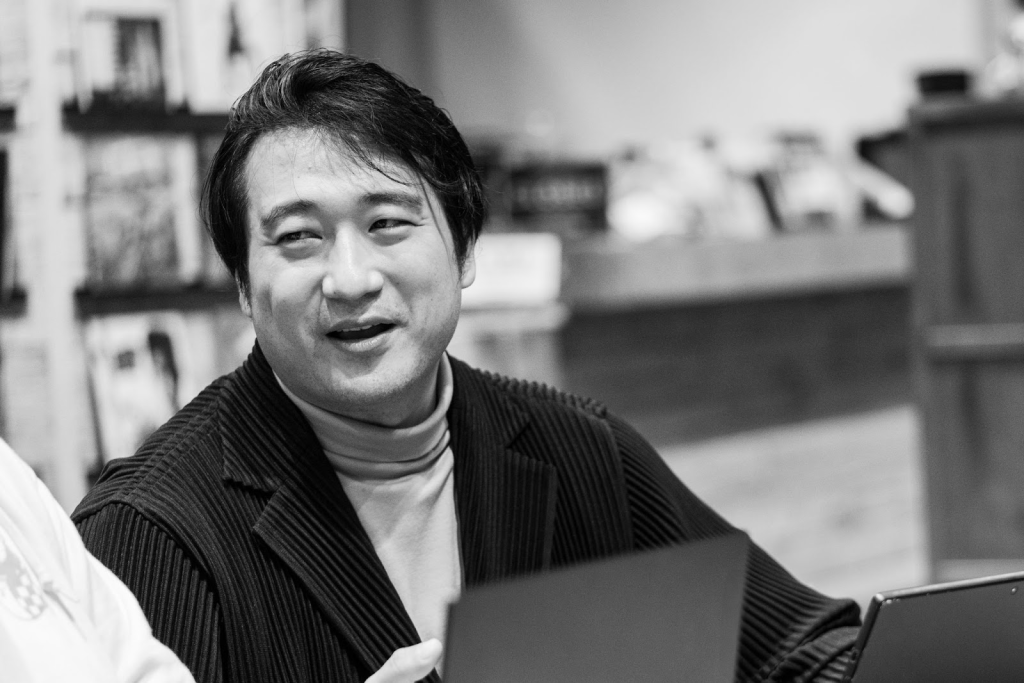
Saito: (quietly in Japanese)
Hmm. Should we go ahead and ask it…?
━━Yes, please go ahead.
Saito:
As a game producer, I really want to ask you… To tell the truth, a game I’m producing now is being released in episode format. I would like to hear from you what things one shouldn’t do when using an episode format. Lessons you learned from trying things that ended up not going so well.
Tony:
Kickstarter was no good.
Of course, thanks to that, we were able to get enough money to reach our goals, which was a good thing. But the issue is that it’s not at all compatible with Steam. I mean, you distribute product keys to use on Steam via Kickstarter, right? When the players review the game with the accounts they used to redeem the game, it doesn’t count toward the algorithm. So in effect, your biggest fans who supported you from your fundraising stage are not there on your release date. That was bad.
Also, Steam early access. I can’t say that it’s the best.
The structural weakness of selling a story-based game in episode format is that the players aren’t guaranteed to return. The player plays Episode 1, think it’s fun, then play Episode 2 and enjoy it. But when Episode 3 is released, will they return? …You don’t know.
It’s been nearly a year since the last episode was released for Scarlet Hollow. Many people replay the game from the beginning. That being the case, you got to be strict in evaluating whether [your game] has replayability or not, and your processes increase.
Abby:
But there is no other way to do it. Regarding Scarlet Hollow, early access was the best choice among all our possible choices. I mean, a better choice than selling it under different titles for each episode or selling it as DLC.
When going with episode format, what the creator needs to really strive to prepare is mystery and cliffhangers. That means creating events that act as turning points within the game’s story. Luckily, that game has good replayability, so players can enjoy the game even if they play it again from the start with the release of each episode.
Saito:
You two temporarily set aside Scarlet Hollow and made Slay the Princess. Was that how dire your financial situation was?
Tony:
We broke even paying rent and buying groceries, but overall [our finances] were decreasing. We had the Kickstarter money as a backup plan, but our account balance was dwindling. As a producer, I’m sure you know how it is. The day that you release, [your funds] go up in an instant. After that, it decreases with each day. You can release new episodes to fuel your project, but that’s still not enough in the long run.
Abby:
Plus, we understood that due to the structure of the game, each episode took longer to release.
Tony:
It progresses geometrically.
Saito:
But in times like that, I’d think you’d turn to financing or investing.
Tony:
We didn’t want to be saddled with debt.
Abby:
It seemed that it would be the start of a bad cycle. We wanted to be independent without being tied down by anything.
Tony:
What we had confidence in was how great Scarlet Hollow was. The hardest thing is getting players to get the game and play it. Everyone likes it as long as they give it a play.
Abby:
you are going to be crazy
Tony:
In other words, our business decision was that If we could release a short game with the same quality as Scarlet Hollow, it’d be a finished game and not an early release, so everyone would buy it and play without putting it off to the side.
This decision was key. When we released the first demo version of Slay the Princess… The sales for Scarlet Hollow increased fivefold. Scarlet Hollow became profitable on its own.
Abby:
In conclusion, if you want to publicize your game, you should make a second game.
Tony:
But it only works if both games are good.
Saito:
Incredible… But making a demo is unprofitable work itself. Allocating resources to that must have been a big decision.
Abby:
What convinced me that we’d succeed was when I saw Tony’s original plans. It was the actual draft that would later grow to be Slay the Princess.
I go back to my parents’ house every now and then and spend time with my family, leaving Tony alone at home. Whenever I do that, he always…
…goes and does something crazy.
So when I came back that one time, he had a demo prepared. It was the first true demo, and only I played it. The graphics were just a single picture: that quote-unquote “Good Ending” you get after you clear everything in five minutes.
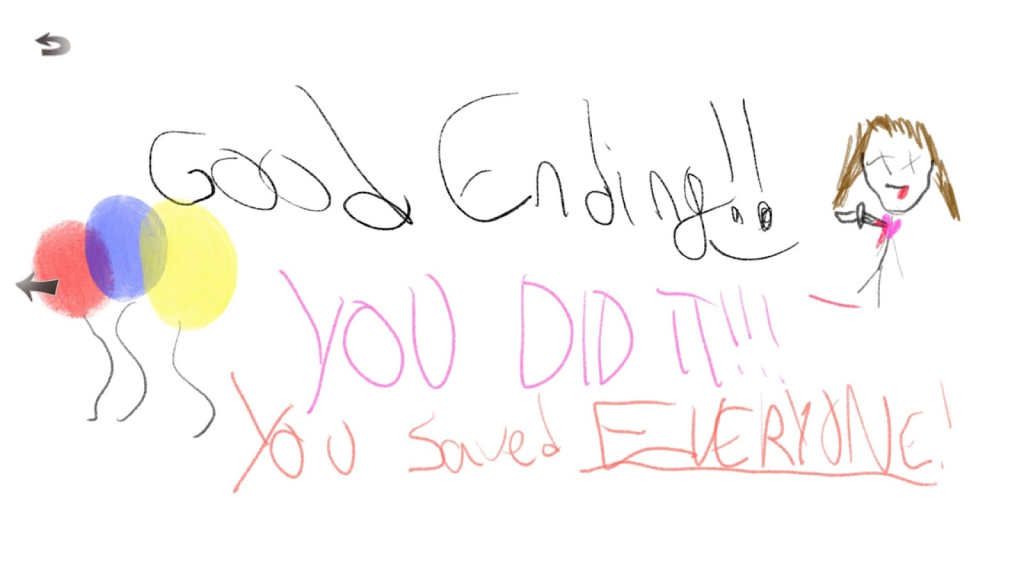
I insisted that we needed to keep this picture in the complete version.
I played that demo, and I knew.
“This is going to be good.”
I thought it was so incredibly interesting.
Tony: (avoiding eye contact)
It was…uh…yeah, risk-hedging.

(looking at the interviewers) Basically, the demo that we first released was created in just half a month. So we decided that we would see how the demo was received to determine how big of a scale to make the complete version. If not everyone liked it, we would have made it a smaller game. But as soon as the demo was released…it blew up. That’s when we decided, “Okay, we got to put our backs into this.”
Saito:(glancing to ━━ then looking over all present)
Okay. Now that I’ve asked what I wanted to ask as a producer, let’s get back to the main route.
“When we look at such simple forms of language, the mental mist which seems to enshroud our ordinary use of language disappears. We see activities, reactions, which are clear-cut and transparent. On the other hand we recognize in these simple processes forms of language not separated by a break from our more complicated ones. We see that we can build up the complicated forms from the primitive ones by gradually adding new forms.
Now what makes it difficult for us to take this line of investigation is our craving for generality.”
–Blue Book, by Ludwig Wittgenstein
━━(clears throat with an “ahem”) It seems that you two struggled with selecting an art style and the production process within the constraints of business. However, from our point of view, the end results feel inevitable.
━━The workings of life are not limited to only things of beauty. Sometimes they include tremendous violence. In other words, living and making art can be scary, anxiety-ridden, and even murderous.
━━That being the case, then perhaps your struggles have culminated in the princess being so multifaceted.
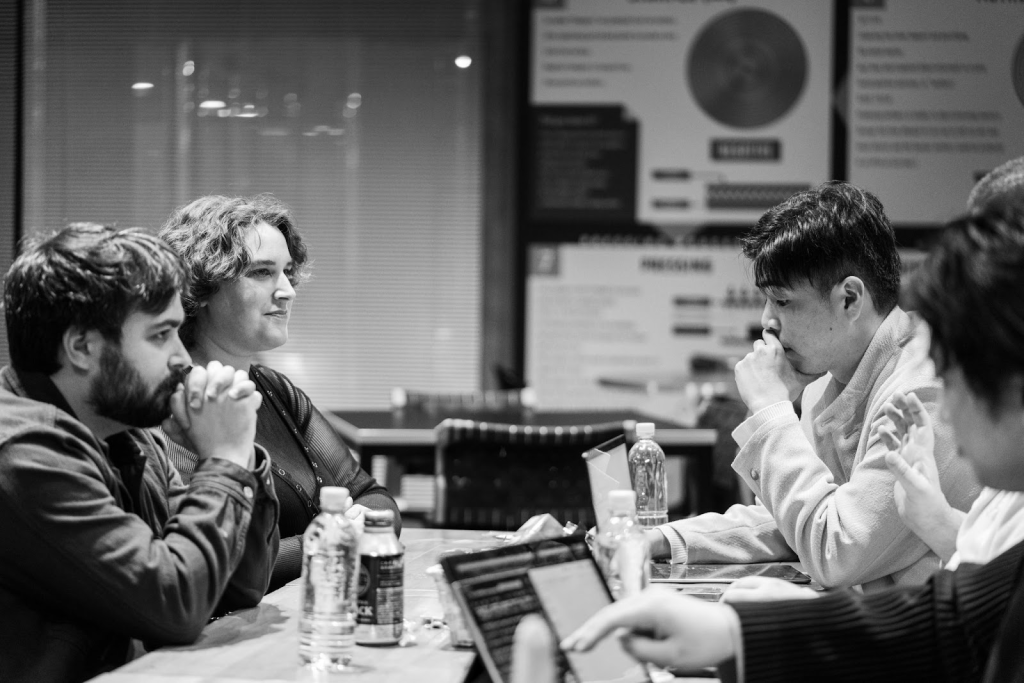
Tony:
Many things were intentional in that regard. The reason is because the story speaks of the volatility of perception and the contradictions of truth within relationships.
The sketch-like style that we discovered also fits perfectly with the theme and what we were trying to make.
The princess changes like water. The visuals and the story are indefinite, like a dream. So that’s why even the environment that the characters are in changes like an illusion…
━━(hastily) But there’s one thing that’s unwavering within that game: the mirror. That mirror never shifts–neither thematically nor in terms of graphics.
Tony: (with a sharp gaze)
Not many players notice that.
(━━ stands up suddenly and begins to pantomime. He reaches out toward an invisible mirror, staring intently at it. He finally lets out a cry of astonishment, then claps as he takes a seat. The Howards laugh amusedly.)
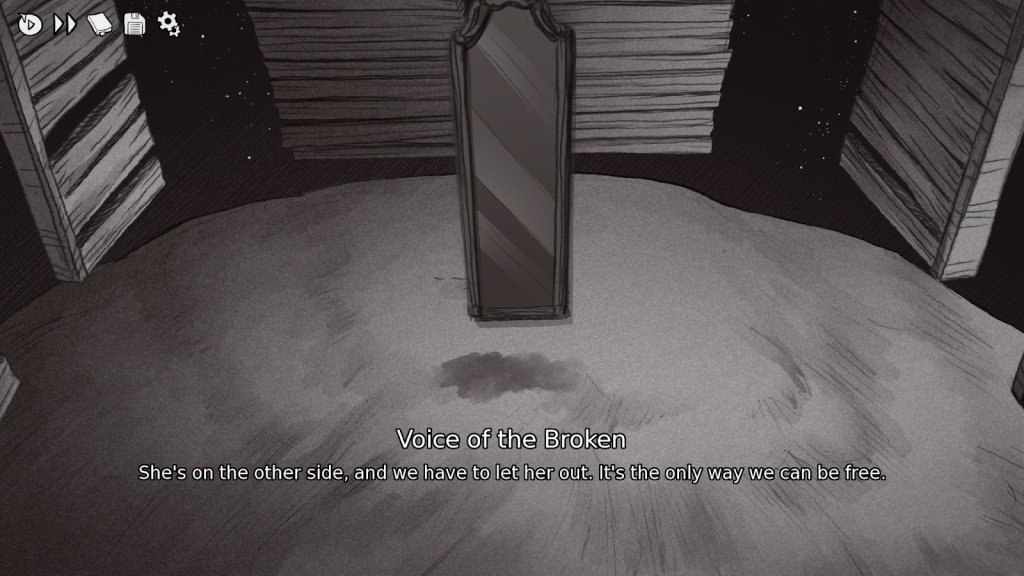
━━That’s how I discovered that the mirror was unmoving.
Tony: (nodding)
We don’t expect all players to discover the technical tricks of the game’s graphics. But I’m certain a lot of eyes are drawn toward that mirror.
That mirror differs from the graphic art style in that it’s drawn with straight lines and has no effect. This makes the player feel that it’s detached from the world.
Even if you can’t put that feeling into words, everyone should understand that there’s some strange tension with that mirror.
━━(stammering) Within the English word “reflection,” there’s also the meaning of thinking deeply about things, in addition to the meaning of reflecting an image.
Tony:
Yes.
━━This game employs both meanings of the word simultaneously.
Tony & Abby:
Exactly!
━━The protagonist reflects the princess. He thinks and thinks, worries, and imagines… Then, just as he imagines her, the princess appears. I thought this was an amazing way of expressing another person’s existence.
━━At this very moment, for example, when we are talking like this… We don’t know what each other will say or do next, do we? We are always in fear of that randomness. And I believe that for the protagonist, the princess that appears just as envisioned or feared is an ideal other person.
Tony: (pleased)
That’s right!
━━And telling another person that you love them is very scary. So I want to say… I love your game.
Abby: (nodding)
Your words hold a lot of meaning for us.
━━(breathing a sigh of relief) I’m glad to hear that.
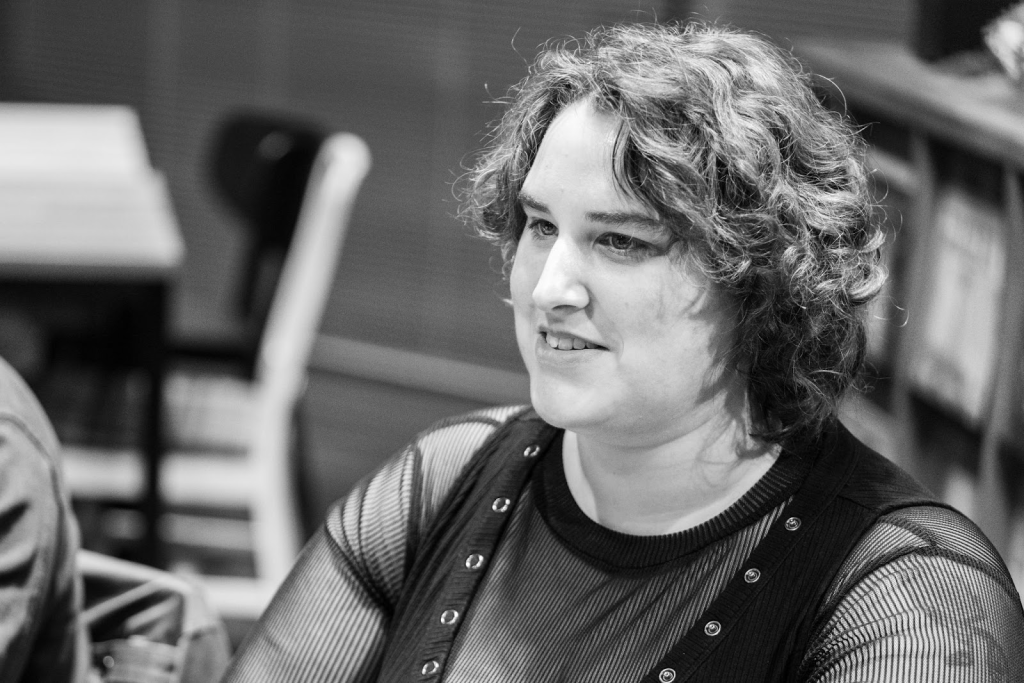
Abby:
A single interaction, just like now, can completely change the way we see someone. First interactions are especially important as they color all the interactions that follow.
The you that lives in the head of another is a separate version of you. The you that lives within your body cannot be known completely by someone outside of you. No matter how other people perceive you, you are yourself, all alone.
It’s very scary to think of the world in this way. But you have to accept it. That’s just the way it is.
Tony: (calmly)
But at the same time, the version of you that others have is also paving your path.
Abby: (calmly)
Right. Sometimes interactions with others hone parts of yourself you didn’t know about and that only emerge through those interactions.
Saito: (nodding)
In our younger years, we learned about love from visual novels. We pondered on love based on the form it appeared as in visual novels.
I believe that games are the best medium to think about and feel love, and Slay the Princess especially has solidified this belief for me.
Tony:
Thank you.
Abby:
Truly, thank you.
Saito:
…With that said, I think ━━ would like to dive deeper into the topic of love.
━━No, I’m still not done talking about the mirror.
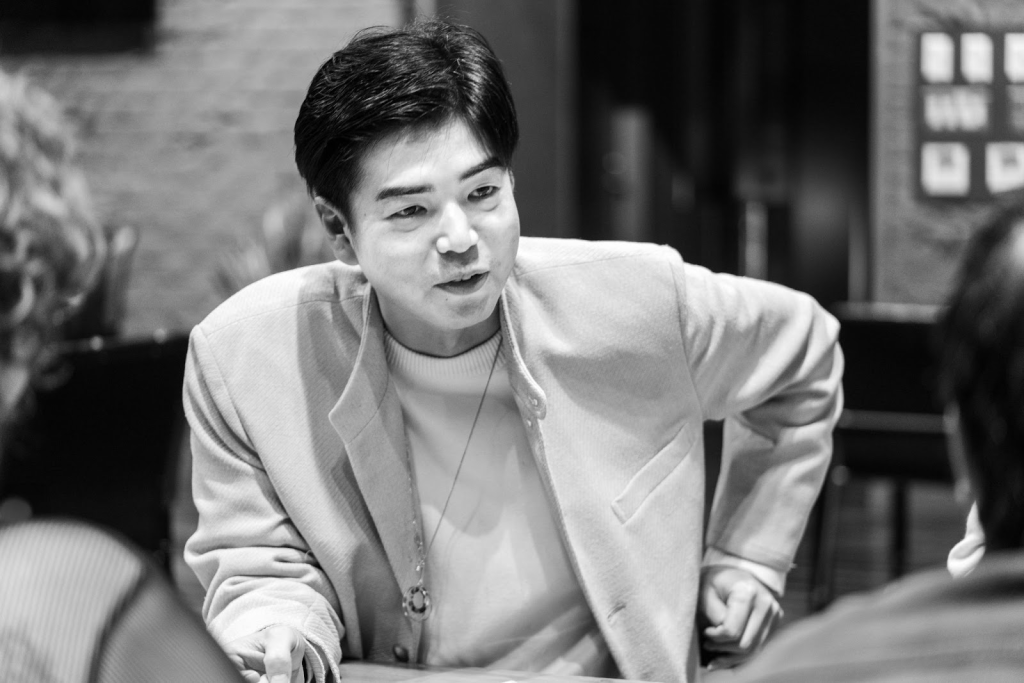
━━This may seem sudden, but here I have The First Epistle to the Corinthians, 13:12.
Tony:
…Oh.
━━Allow me to read:
“For now we see only a reflection as in a mirror; then we shall see face to face. Now I know in part; then I shall know fully, even as I am fully known.”
I remembered this passage when faced with the Long Quiet and Shifting Mound in the latter half of the game. To what extent did you two consciously adopt this religious context?
Tony: (after a momentary silence)
…We explored a lot of ideologies.
…Give me a second to think.
…Hmm.
My dad loved Bruce Lee.
When I was five years old, I learned martial arts, and the dojo I attended was descended from Bruce Lee…
So I was familiar with Eastern religious philosophies, including Buddhism, from a very early age. “The Way” was instilled in me during my most formative years. I learned a lot about mythology and religion in college as well. I’ve always been influenced by these…
(raises his head confidently)
So I think the most fitting word to describe the game Slay the Princess would be “exploration.”
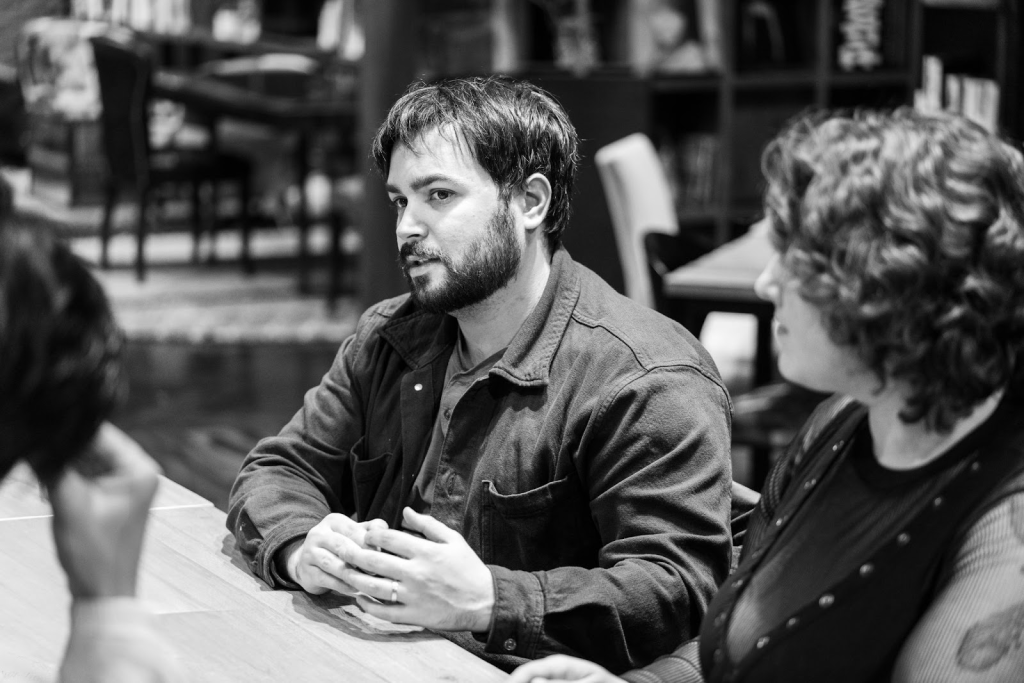
As story writers, we’ve created two works. Scarlet Hollow is a very down-to-earth game. There are no supernatural elements to its mystery, it’s rooted in logic, and it’s concrete. After working out all the details first, we began writing the game’s text.
In contrast, Slay the Princess has a shape-shifting, expansive story structure. In the beginning, we only had a concept, so writing meant exploring this concept and bringing it to a logical conclusion.
The structural elements of Slay the Princess are actual very simple: an assigned mission and an environment. A forest, a cabin, a blade, and a princess. And the end of the first chapter is all about exploring the possible permutations of the actions the player can take in response to these elements.
This exploration required us to constantly reflect: What would the player do if they’re in this situation? What would happen if someone was thrown into these rules that we set and then told to kill the princess?
Hmm. There are too many prerequisites to understanding what I’m talking about. Everyone reading this interview has played Slay the Princess, right?
https://store.steampowered.com/app/1989270/Slay_the_Princess__The_Pristine_Cut
Anyway, the structure of the final version of the game is like this:
The player plays through five routes, and a meta-narrative brings them together at the end.
In other words, you get a new perspective to take to the Shifting Mound, and by doing this, the god manifests.
But in the initial version, the player only continued to interact with the princess, to the point where your thoughts drifted away from logic.
━━And when that happened…
Tony:
The god would appear. She would turn into a god.
Through this, the player was able to gain a kind of enlightenment.
We thoroughly scrutinized the structure of this initial version. Then…we realized that it would be much more interesting to explore multiple paths and expand on those, rather than [make the princess] turn into a god in a single play-through.
And as soon as we rearranged the structure in that way, the very nature of the princess’s divinity also changed. Rather than turning into a god through the player’s thoughts, you see her as an innately divine being.
━━Not all routes in the game are necessarily full of religious reflection. Rather, each one seems to be a possible love relationship. For example, the protagonist and the princess constantly kill each other in various versions. But the text in each can be read as a lovers’ quarrel in which they care for each other so much that they don’t know what to do. And then these experiences, including this pain, are offered to the “Shifting Mound” god.
Tony:
When exploring this concept, the religious reflections that we used are like a magnifying glass, so to speak, for the purpose of observing divinity and death, change and mortality.
So as we were examined these concepts in detail, many of the ideas that emerged resembled that of Eastern Thought, with Taoism being particularly important.
And of course, Western ideologies are with us in our everyday lives. For example, the princess immediately before the Shifting Mound awakens is almost Christ-like.
What that means is this…
On the other side of this suffering, this pain, this terrible life full of violence…
Don’t you think how wonderful it would it be if she were there?
What if we could meet her one more time before we return to the place we were before, to get to know the princess and her core…
━━Her core?
Tony:
I mean, that she loves you.
She loves you unconditionally.
No matter what horrible things you did to each other up until that point, there is forgiveness.
━━That was in the The Book of Psalms. “For thou, Lord, art good, and ready to forgive,
And abundant in lovingkindness unto all them that call upon thee.”
Tony: (nodding)
I mean…yes… If you’re making a game about gods loving each other, there will obviously be religious reflections.
━━The reason why the religious motifs–whether Eastern or Western–are not merely pretention is that you have fought through the struggles of your own lives. First, there is your life, and then you use ancient teachings to logically explain the interpretations you have gained from your experiences in some way. That is why the text is so powerful.
Tony:
That’s right. This truly does not get across.
When we talk about our entire studio’s [portfolio], Scarlet Hollow is an episodic visual novel with early access, and it’s very long. It wasn’t earning the money itself for us to complete it to the end. So we made Slay the Princess…. That’s true. And as a studio, we want to be as transparent as possible to our fans regarding what we are doing…
But there are some people who say, “Oh, Slay the Princess is a marketing piece for the purpose of completing your life’s work.” That’s not it. The reality is that that’s part of it, but it’s by no means just that.
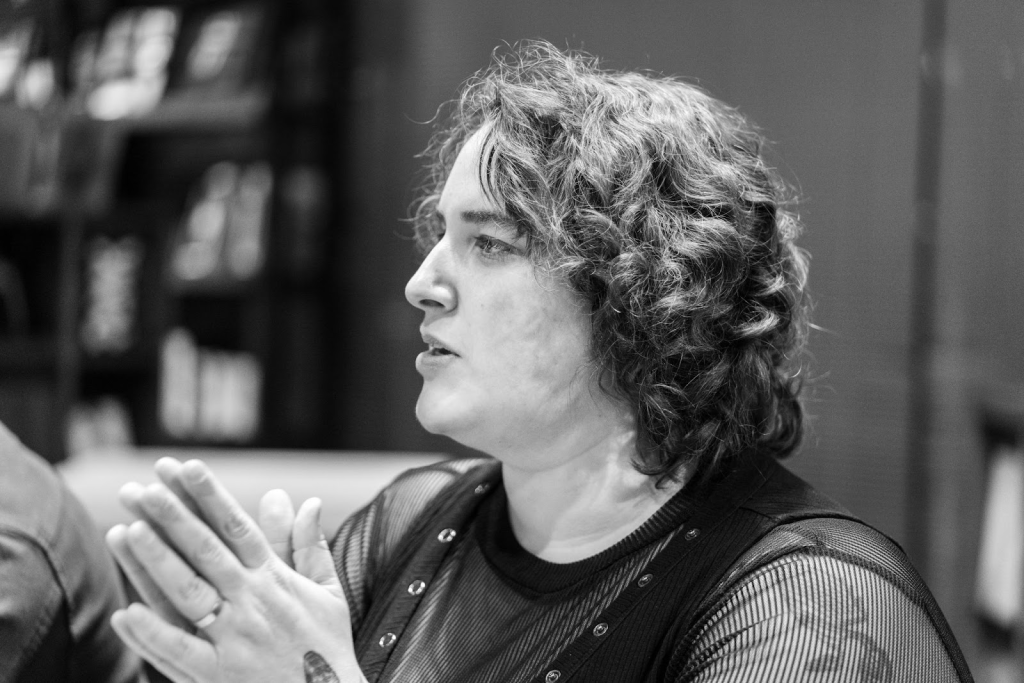
Abby: (emphatically)
If we didn’t want to make it, we wouldn’t have made it. We don’t make things if we don’t have passion for them. We make the best games we can with the skills that we have at the time. That’s it.
Tony:
Right. We put our heart into everything that we do. We always give 100% of our energy.
━━Let’s shift from Western ideology to Eastern ideology. In the Shifting Mound’ lines, there’s this quote:
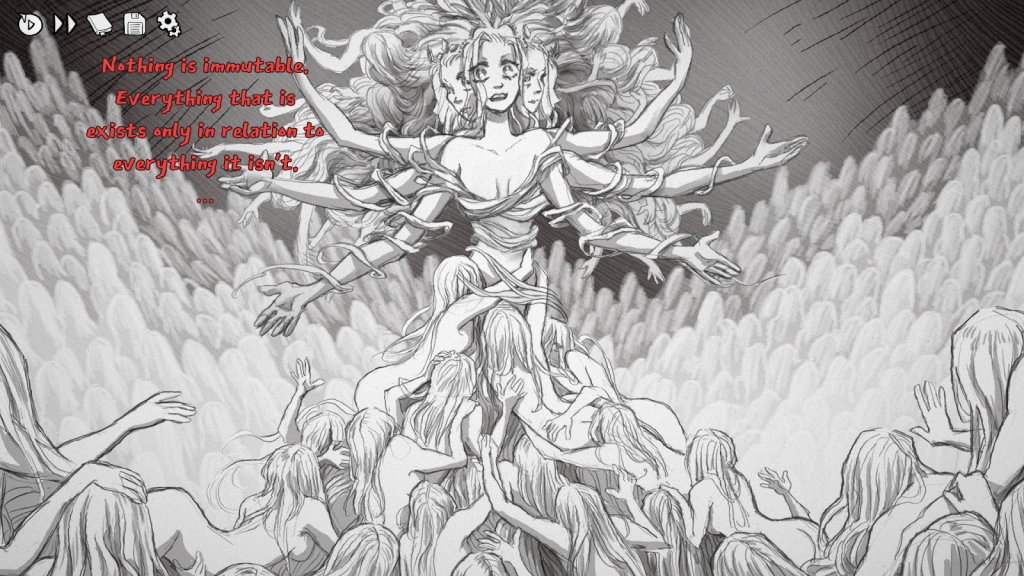
”Nothing is immutable. everything exists in relation to everything it isn’t. there is no constant, there is no center.”
━━This very closely resembles what the great monk Kūkai preached roughly 800 years ago. He said form is emptiness. Were you aware of this concept as well?
Tony:
When writing that question-and-answer scene, I found myself repeatedly going to my bookshelf and cracking open Taoist and Buddhist scriptures.
Let me quote the teaching I discovered then:
“The Tao [Way] that can be told of is not the eternal Tao; The name that can be named is not the eternal name.”
Writing those questions and answers was a challenge because we were essentially trying to convey to the players something that can’t be conveyed through words or pictures.
Abby:
But we had to make do with what we had.
Tony:
How do you convey something that cannot be conveyed? Buddhist teachings–and Zen teachings in particular–gave me the frame of mind to move toward our goals.
The discussion subjects with the Long Quiet and the Shifting Mound contain within themselves logical contradictions. But we only had words, which are the product of logic, and graphics, which are translations of symbols.
So we ultimately became one with the ideas.

Abby:
We became one to clarify what it is that you pursue, to more clearly define the emotions and thoughts you have toward that theme.
━━And what resulted from taking the arts to such extremes was…
Tony:
Poetry.
When Zen priests teach this to their disciples, they pose a question with logical contradictions.
That’s because this cannot be solved no matter how you think.
But when you try becoming one with this…when you try becoming the question posed itself and live it, it clicks in your head and you understand.
━━(suddenly realizing) Zen riddles! …But… No, we shouldn’t go down that rabbit hole. This is a Western-style interview based on words and logic, after all. So then I hope you don’t mind me suddenly shifting to some critical questions.
Tony:
Not at all.
“In nature we see everything, from metal to organism, corroded and consumed partly by its own existence, partly through conflict with something else, Now how could nature, throughout endless time endure the maintenance of forms and the renewal of individuals, the countless repetition of the life-process, without becoming weary, unless her own innermost kernel were something timeless and thus wholly indestructible, a thing-in-itself quite different from its phenomena, something metaphysical that is distinct from everything physical? This is the will in ourselves and in everything.”
–Parerga and Paralipomena, by Arthur Schopenhauer, translated by E. F J. Payne
━━The mirror in the game is a construct, the five senses themselves that perceive it.
Abby:
Yes, you could say that.
━━Then it’s smashed into pieces, and afterward the Long Quiet faces the Shifting Mound.
Tony:
Uh-huh.
━━But…if your senses are smashed, then I would think that there would be nothing there. I suspect this to be my opinion on life and death. Nevertheless, you two depicted another person on the other side: the Shifting Mound. So that means that you two believe that someone must be there even after death, that you can meet her one more time.
━━So here’s my question: how do you have the strength to believe this?
Tony: (bringing his palm to his head)
…Jesus, what a question.
━━Sorry.
Tony:
No, no. It’s okay. It’s a…
…a hunch.
Every time the princess is recovered through the Shifting Mound, the protagonist looks into the mirror. Each time, his body decays. That is a contemplation on corpses. Do you know what I mean?
━━Yes. In the Japanese Buddhist tradition, there is something called kusōzu . It’s a contemplation on the reality of all living creatures through the depiction of the stages of a decaying corpse.
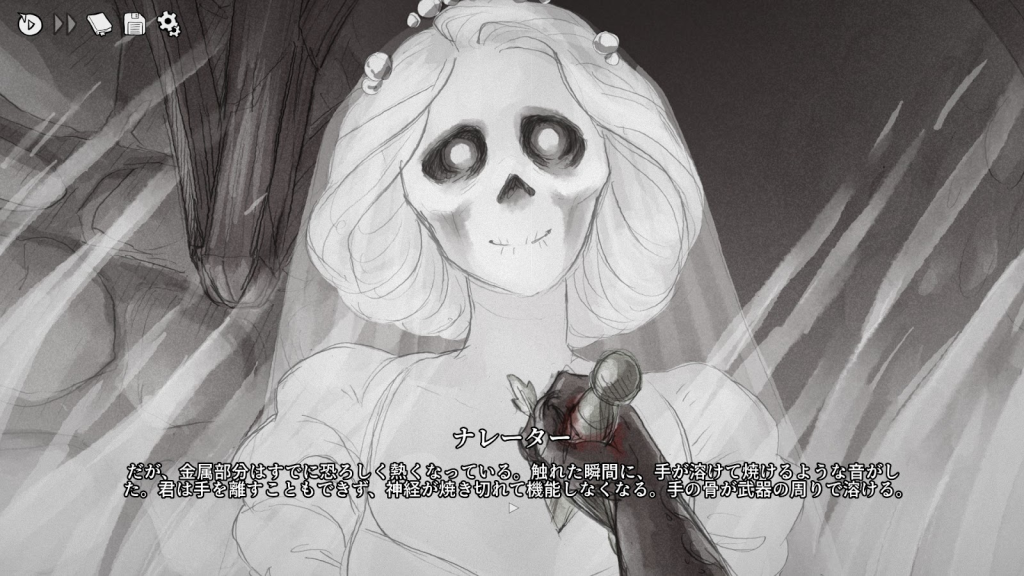
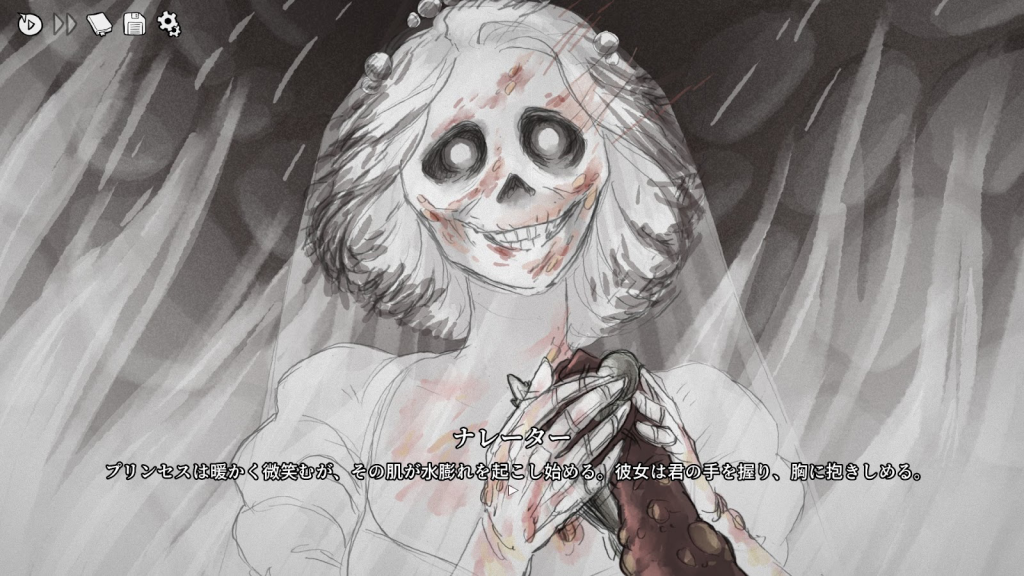
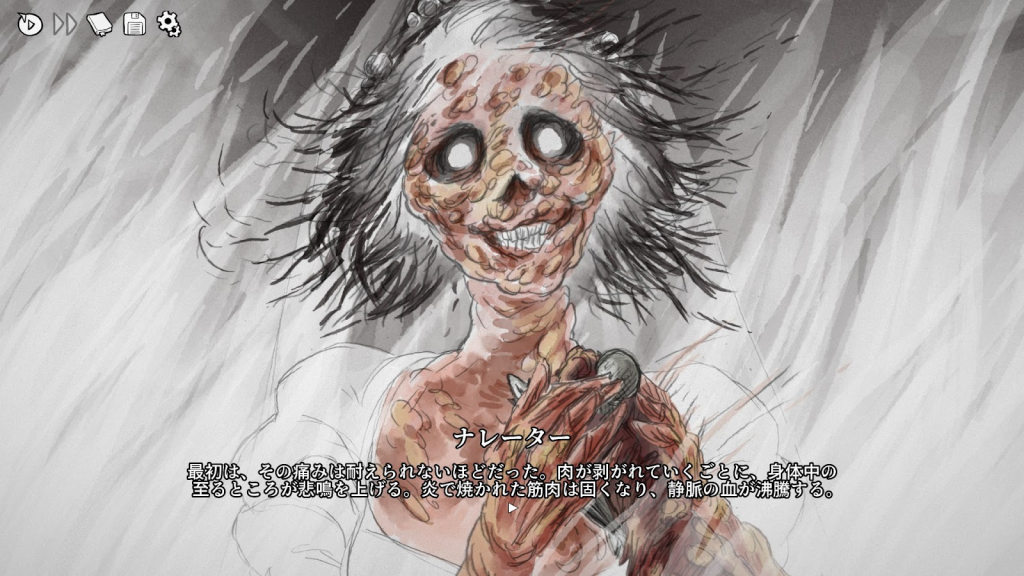
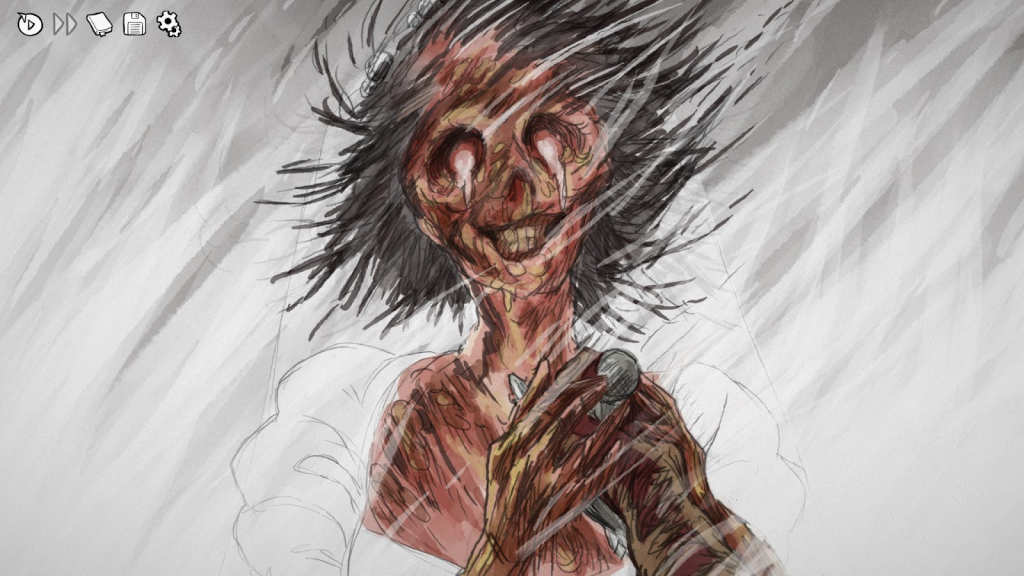
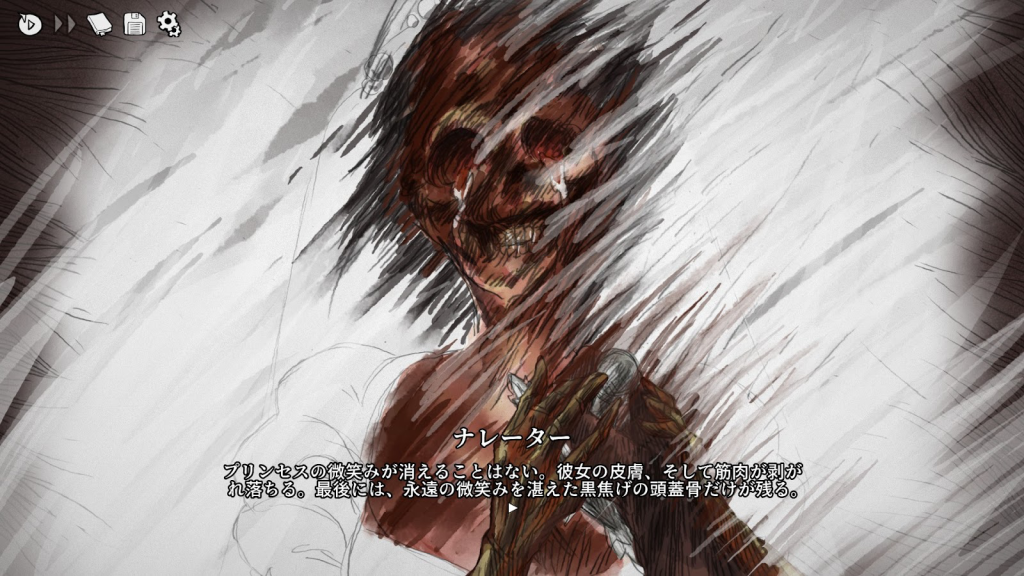
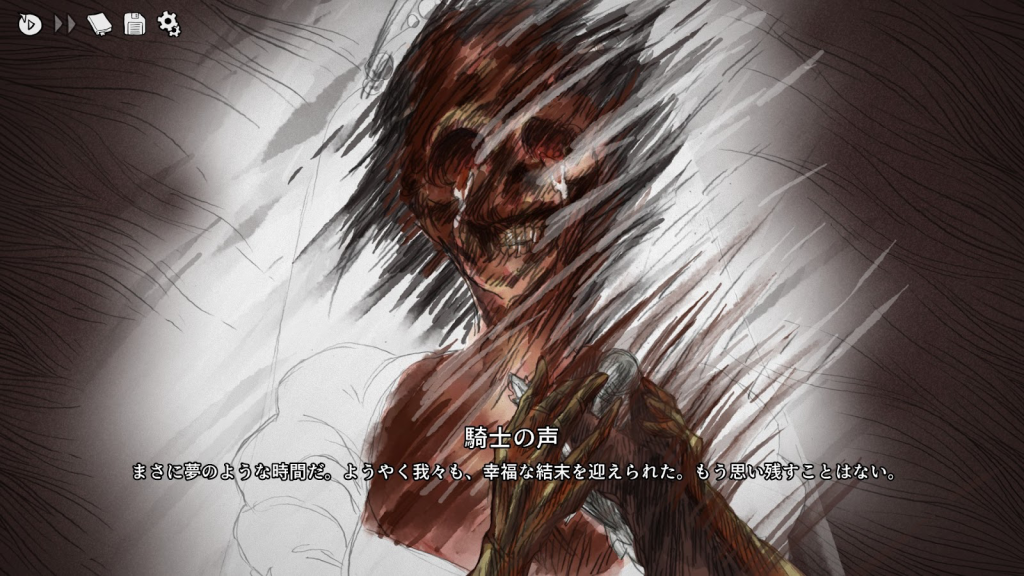
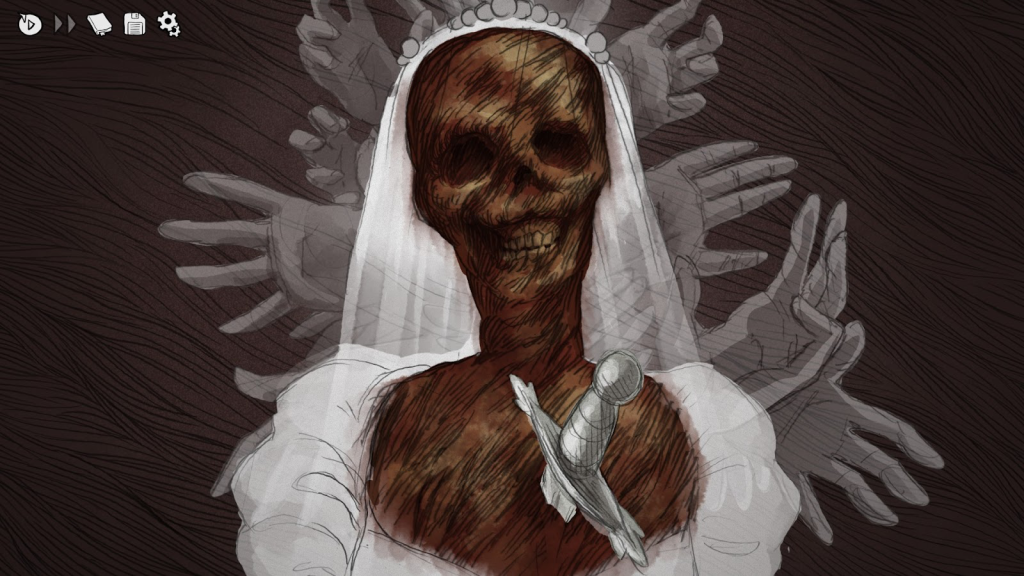
Tony:
Hmm. But after everything has disappeared, you’re still looking at the mirror. You note that this is strange, and it is, logically speaking. But I…I can’t help but feel that there is something there. A void.
━━Now that I’ve played the game, I’m coming around to that opinion. The reason being that she is definitely there after the mirror is smashed. The Shifting Mound exists there in all her glory thanks to Abby’s drawings… The moment of that encounter is as if coming face-to-face with the Thousand-Armed Kannon. I was deeply struck.
https://upload.wikimedia.org/wikipedia/commons/c/c9/Senju_Kannon.jpg
Japan national treasure The Thousand-Armed Bodhisattva Kannon, late Heian period
Saito:
You two may find his opinions on life and death difficult to understand, but they are something that any Japanese person can intuitively understand. That’s because being incredulous of another’s existence is an underlying theme in our culture. This is by no means limited to games; it’s been our tendency since ancient times.
But contrary to this, you are completely convinced of the existence of another. The strength [of your conviction] astonishes us.
━━Is that what love really is?
Abby: (looking at Tony)
We did a lot of exploration on the subject and concept of love.
Love is not just about two people being nice to each other. It’s love no matter the relationship between the two people, even if it’s a bad relationship, even if their interactions have completely ended.
So there is value in exploring that. That’s one of the things we tried to depict with the game.
Tony: (relieved)
You’re really good at tying everything together.
Abby: (smiles)
I like making things short and concise… But, well, I’ll add that the important point of the game is that the princess is the only person in that world who isn’t you.
━━Now I hope you don’t mind if we discuss the ending.
Tony:
Of course.
━━Broadly speaking, this game has three different endings:
1. The Long Quiet and Shifting Mound unite and set out towards an infinite beyond.
2. The protagonist and princess join hands and leave the cabin.
3. The Long Quiet kills the Shifting Mound and, in doing so, creates a world devoid of death.
━━I believe that these three [endings] express the same concept. The last may seem to differ from the other two at first glance, but if everything is permanent then there is no discernment, and therefore, the Long Quiet and Shifting Mound are indistinguishable–I mean, they are logically one.
━━However, in a world without death, even the possibility that the Long Quiet and Shifting Mound once existed there is killed. It’s sad. It seems like a bad ending… But either way, the two leave that world together.
━━If that’s the case, then was what you were trying to express not the end result but the journey to get there? Leaving is inevitable, but rather it’s a question of how you leave, correct? …(suddenly snapping back to reality) What are you thoughts about this?
Tony: (struggling)
…What? What do we think…?
Abby: (smiling brightly)
Come up with something lovely and poetic!
Tony: (very slowly)
…The game is…
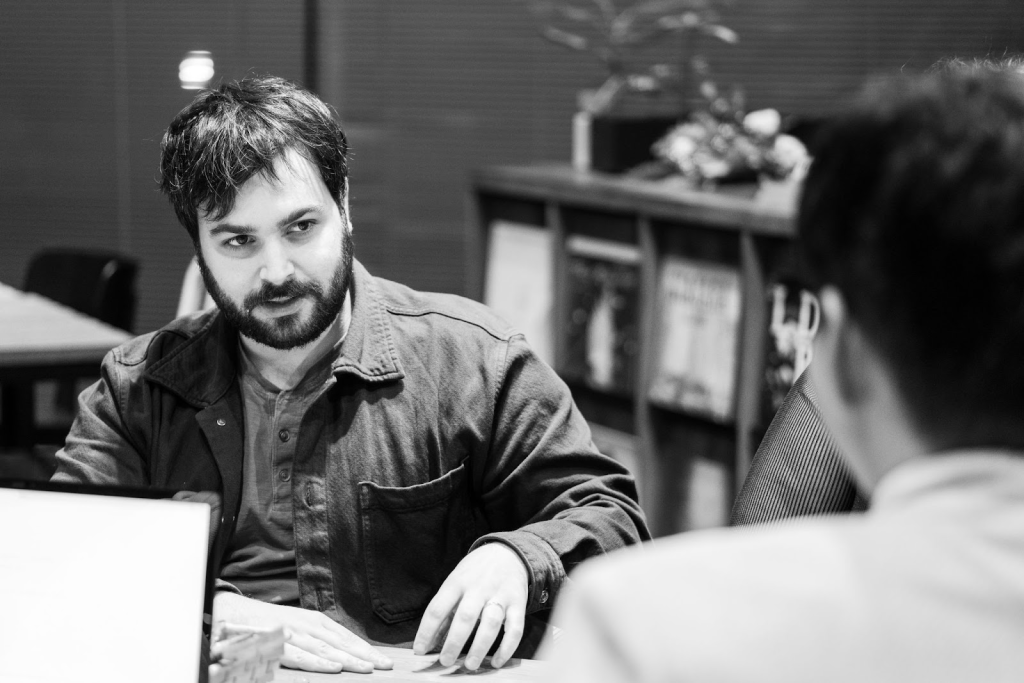
It’s asking players to reflect…on the state of death in this world and death’s strong transformative powers.
(gradually more articulately) …In other words, all answers are valid within their own logical architecture. If they are valid, then they are other paths.
And all paths ultimately lead you to the same circumstances.
So the problem is…which path the player themselves choose. Your choice is important.
Abby: (unequivocally)
All endings reflect on the fact that I am freed from the idea that I must change things. After all, death will come someday, to all of us. And in the game, it comes many times over.
Change comes either through your actions or through nature. Everything changes.
Tony:
Yes. So the hope we instilled in all the endings is that the player abandons their fears.
Letting go of fear is the ultimate [expression of] love.
You know, we are sitting here like this now and talking a bunch trying to put this into words. But the most important thing is how those endings felt to you.
And when you come to the ending that you think is the right one, there’s an emotional catharsis to it. You have a feeling that this is right, that this is good.
If that is what happens at the end, it means you have let go of your fear.
Saito:
I just remembered that you, Tony, majored in psychology. Did you reference anything from that field [while making the game]?
Tony:
…Hmm. Psychology, if handled properly, is another [set of] teachings. It helps guide others and helps them find their natural states.
A psychological approach is certainly more important when writing a game, the reason being that for the writer, the player is the most important character.
The player character has an almost infinite number of possible trajectories. This has been taken to an extreme in Slay the Princess.
The game is driven by a story and choices, and the role of the player is always active. They think with their own mind, feel with their own heart, and choose their dialogue options with their own hands.
But more generally, that’s what video games are. The player is the protagonist even in video games without stories. Even Pacman has a narrative.
Let’s say for example that you play Pacman. You’re a different character than from when I play. And when Saito-san plays Pacman, he’s yet another different character…
(sighs) When making games, you have to take everyone into consideration. Am I right?
Abby:
And capturing everyone is impossible.
Tony:
Right. Take this story about a certain [type of] player, for instance…He or she does exactly as the narrator tell them from beginning to end and kills the princess in five minutes. Then they write a Steam review saying, “This game is overrated. It only took five minutes, and nothing happened!”
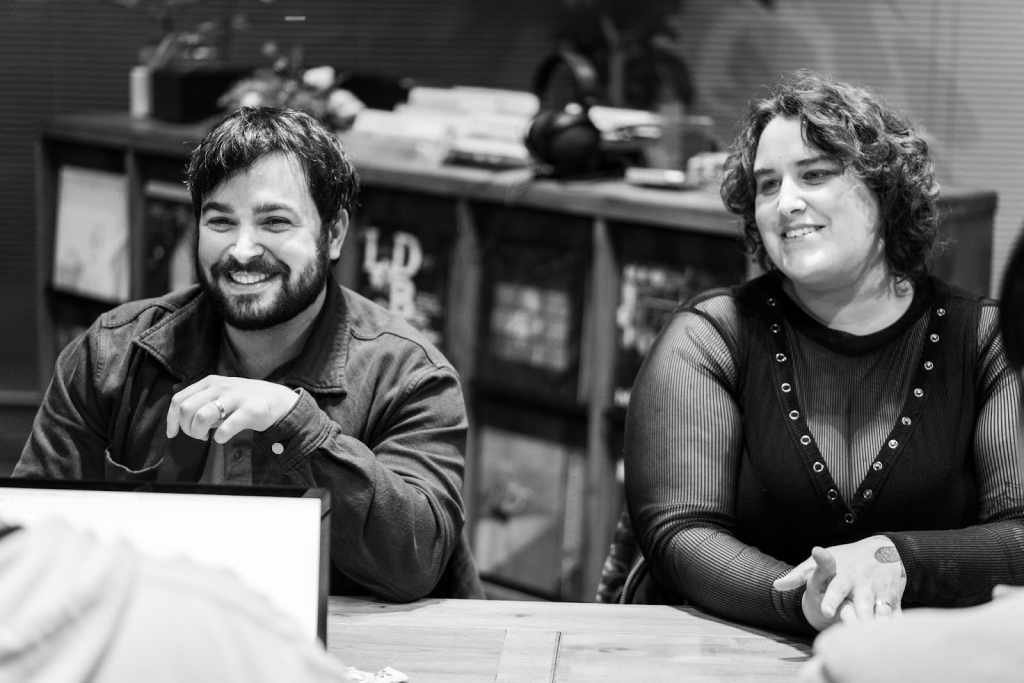
(all laugh)
Abby:
And then other people ask, “Hey, didn’t you try pushing any other buttons?” They say, “No, I’m not interested in that sort of role-playing.” It’s… How do you put it? Like, “Really? Okay, sorry.” (laughs)
Saito: (supportively)
Such people may not know fear.
Abby:
They don’t need fear because they’ve conquered it!
Saito:
But many people know what fear is. And your game aims to get the player to let go of their fear. I think it’s like a psychological therapeutic process: making the player face their fear, giving it form, and making them let go of it.
Tony:
That’s the ultimate job of an artist. All art is for that purpose: to expose people to perspectives other than their own, and to reflect on those perspectives within themselves.
Abby:
The horror genre is really good at doing that. It truly makes you face your fears over and over again. That’s why there are also horror elements in Slay the Princess. I myself like things that are a little scary and exploring dark themes.
Tony:
Good art, games, and stories are all mirrors that you don’t realize are mirrors.
The player faces these, adding reflection after reflection to themselves, even as they are unaware that they are reflecting.
Like this, the writer touches the hearts of people and unburdens them, instead of standing next to them and shouting loudly for change.
Slay the Princess has a literal mirror and a second mirror. The second mirror is the princess, though it is not necessary for the player to realize this.
She is a reflection of your thoughts and actions, and through that reflection, the player sees themself.
You touch the hearts of others, further your own exploration, and discover new qualities hidden within yourself.
━━It just occurred to me that the princess is not just a mere mirror but also flesh, though perhaps not flesh in the real sense, but a figure. If so…then why she is a princess and not a prince?
Abby:
That is because we needed to enhance the contrast between the protagonist and the princess… I’ve explained it better before…
Tony:
They are like yin and yang.
Abby:
That’s it! They are two different subjects. The princess is light and the protagonist is darkness. The princess’s various states are all inverse images of you.
You act on her, and then she reflects actions onto you. This is a new side of yourself you could never discover on your own.
In other words, she strips away your armor and shows you the real you as others see you.
That’s why the two are inverses of each other, with her being feminine and you being masculine. This way the contrast continues.
Whatever the Voice of the Hero says to you…to you, she is special.
I thought really long and hard about this at the very beginning. Why is she this important to me? Why is she so important and beautiful?
Tony:
To add one thing: in traditional storytelling, and also video games especially, princesses are objects that are extremely typified and have a prescribed role. In most works, a princess waits to be saved by someone, and when no one saves her, other people’s intentions are projected onto her. Since this archetype is so well-known, flipping it upside down makes it very effective at destroying your armor.
And simply, no one had used a title like “Slay the Princess,” and…a title telling you to kill a princess would seem to sell better than one telling you to slay a prince, would it not?
Abby:
Another example of the blending of marketability and creativity.
Well, there are things that you do yourself that you’re not sure why you did them. The reason for going with a princess instead of a prince is one of those.
Saito:
I understand the marketing reasons as well as using the archetype associated with the role of a princess. But… That alone does not explain why she has such wonderful individuality. Was she modeled after somebody specific?
Tony:
No, she wasn’t.
Abby:
The model for the princess was the distillation of the countless concepts of princesses from all other works.
Tony:
In the West, a princess conjures up two different images: the first is European—particularly English royalty. And the second image is that of the Disney [princess]. Video games tend to lean toward the later, so we went with this angle.
Abby:
With the huge eyes.
Tony:
A cute princess.
Saito:
I know it may be rude, but as someone in media I must ask… did you use yourselves as models?
Abby & Tony: (laughing)
No, not at all!
━━(laughing) So how did you create the protagonist?
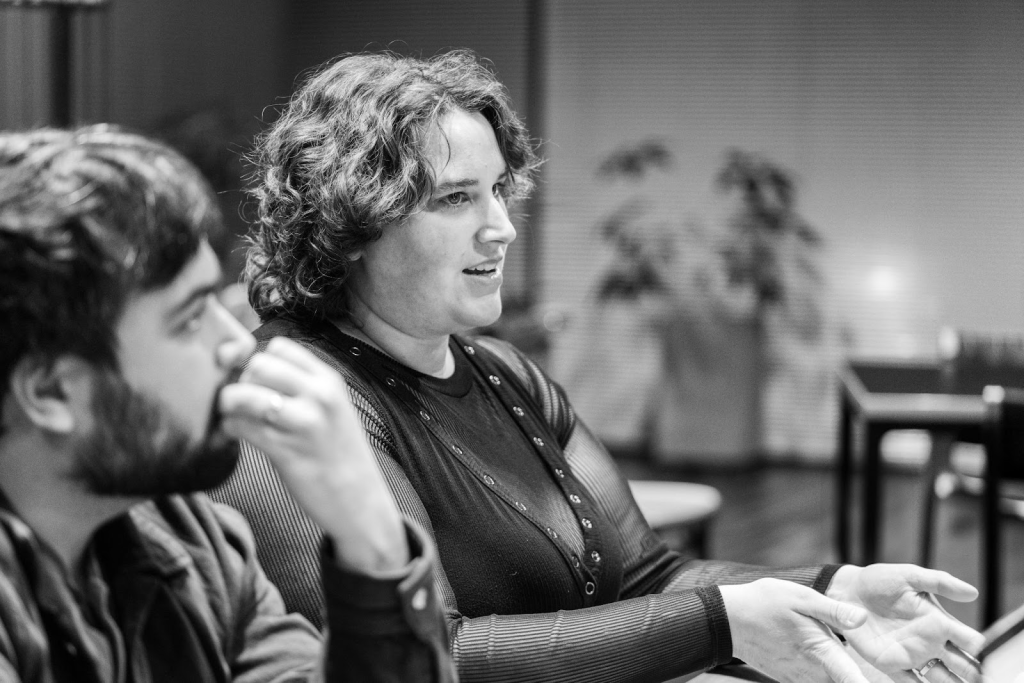
Abby:
Well, first, we were very drawn to the idea of the protagonist or player gradually realizing that they were something monstrous.
You unconsciously believe that you are the protagonist starting in the first chapter.
As a single person, you have discretion and choose to pick up the blade and head down into the basement.
Then she is very nasty toward you.
Lots of people who played the game asked us, “Why is she so mean?”
But…let me say this.
You’re the one that’s mean.
When you head down into that basement, you’re the one holding a blade in your hand.
That’s how you were, and you don’t even realize at all that that is how you were seen. But she sees you that way, and that’s what…influences your relationship with her. She lashes out at you, and you lash out at her, and it goes on and on until things get uglier and uglier.
In this manner, you repeatedly look at yourself in the mirror and reflect on your own deeds, learning that you do not completely understand yourself. You reflect on what you are. And your worries grow.
Tony:
You need to have a certain state of mind to appreciate a love story, and it’s quite the opposite to what Western gamers in particular are used to.
They see games as things to be solved with reasoning instead of interpreted with emotion. They can only see games as win-or-lose.
Such minds are as if clad in armor.
So our game must first de-arm the player through its own mechanisms and power.
The monstrous nature of the protagonist, i.e., the player, is a mechanism for the player removing their faith in Western ideology that serves as their armor.
After all, in the first chapter, you enter the basement and see that the princess appears more or less human, and you imagine yourself to be human too. But the circumstances and what the narrator is saying seem not quite right. The second chapter looks like it’s looping, you hear another voice in your head, making you even more confused, and you meet the princess again–but what the heck is she?!
You can no longer trust her because she has changed.
And ultimately, you face the mirror. You discover your own monster-like hands and figure. You think, “My God, I can’t even trust myself!” When this happens, all your established beliefs are destroyed, exposing your heart and rendering you emotional.
That means that your heart can be easily connected to a love story.
The conditions are right so that the space between you and the princess is bridged with not a logical connection, but with an emotional one.
Saito:
But then the princess must have individuality or else what’s the point? The princess reflects a lot of things in this game. She takes on many duties and plays many roles. Such a large number of roles can sometimes crush individuality. In meta games in particular, characters tend to become tools for meta roles.
━━But the princess has such strong individuality that this is not the case for her. How were you able to create it this way? As many games fail at accomplishing this as there are stars in the sky, so how were you two able to pull it off?
Tony:
When writing characters, the writer needs to step into their shoes and investigate them. You need to find out what they feel, give their existence shape, and discover what experiences led them to this place.
Abby:
And you need to find out what they want for the future.
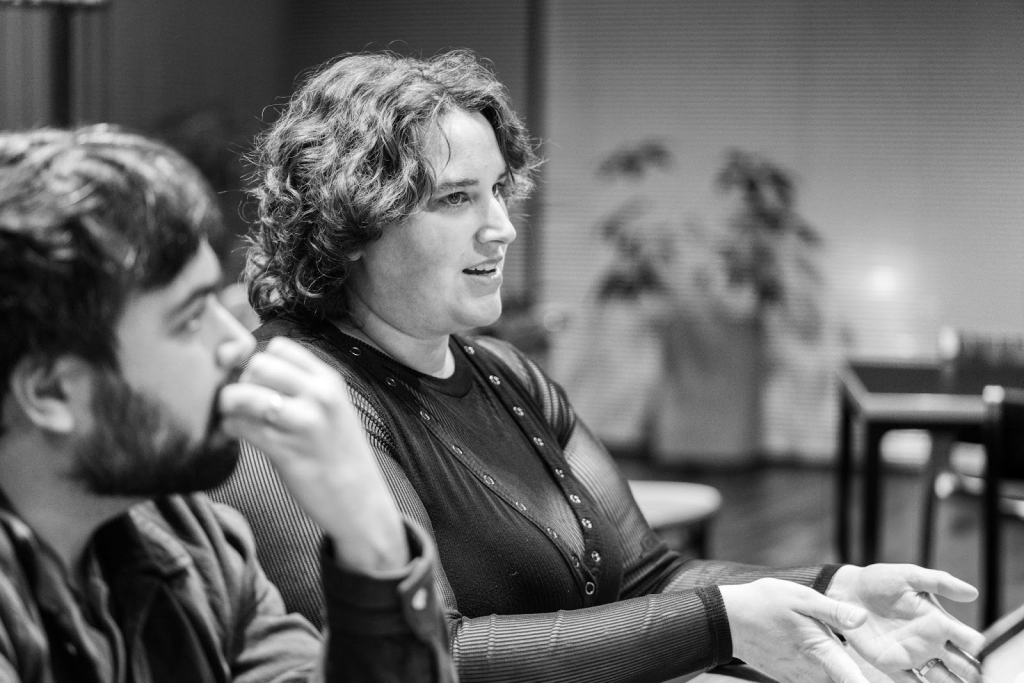
Tony:
That’s right. And at the princess’s core is a strong will to live. To her, the player is something important to her survival. That emotion is there without any reason, like a basso continuo.
They were very interesting characters to write, because if this were a more realistic story, there would be the characters’ past experiences [to consider]. Like what movies they’ve watched, what books they’ve read, who their friends were at school.
But the princess in the first chapter is very basic. She is being held captive there. That’s all she knows. She only instinctively knows the faintest of details of who she is.
But in the second chapter that follows, we can use our experience of the events of Chapter 1 to do deductive reasoning: What is it that happened between the player and the princess up until this point? How did these experiences shape her? What individual characteristics will she gain? …And as she faithfully reflects these results, she fits perfectly into the box created through her experiences with you in Chapter 1.
Abby:
These transformations are what best demonstrate that you are important to her.
Her transformations are her love for you. She discovers that you are important [to her], and this fact is expressed by her transforming in many different ways.
She’s such a difficult partner because her love can be violent or it can turn her overly dependent and clingy.
But she can’t help it. What she really wants is to give you whatever it is that you want from her.
And that is…
Um, sorry. I forgot what I was going to say.
━━In Japanese, there is the word “junai (純愛)” which I believe translates to “pure love” in English.
Abby:
Yes. That’s it.
The princess is the central hope.
She’s not just a weak girl held captive in that dark basement idly wishing to get out.
This whole time, she has been trying to say…
“I want to be born. I want to be born into this world. I want to be born into this world again and experience everything. I want to discover who I am, I want to see who I can become!”
And you are hindering these intentions.
Because the story has ordered you to slay her.
Tony:
That’s right. That’s her core. But she has only a faint grasp of that core. She doesn’t understand what she does not have, because she has never had it before.
In this sense, her journey closely resembles that of the player. The path the player takes to discover themself is also the path that she takes to discover herself. Both seek it without even knowing why they seek it… Their paths continue in parallel.
Abby:
It is so important that you are here right now.
Because without you, none of this would have happened.
Because you are there, she can turn to you and say…
“Hey, we’re in this together! Look! Look at the world! It’s so beautiful!”
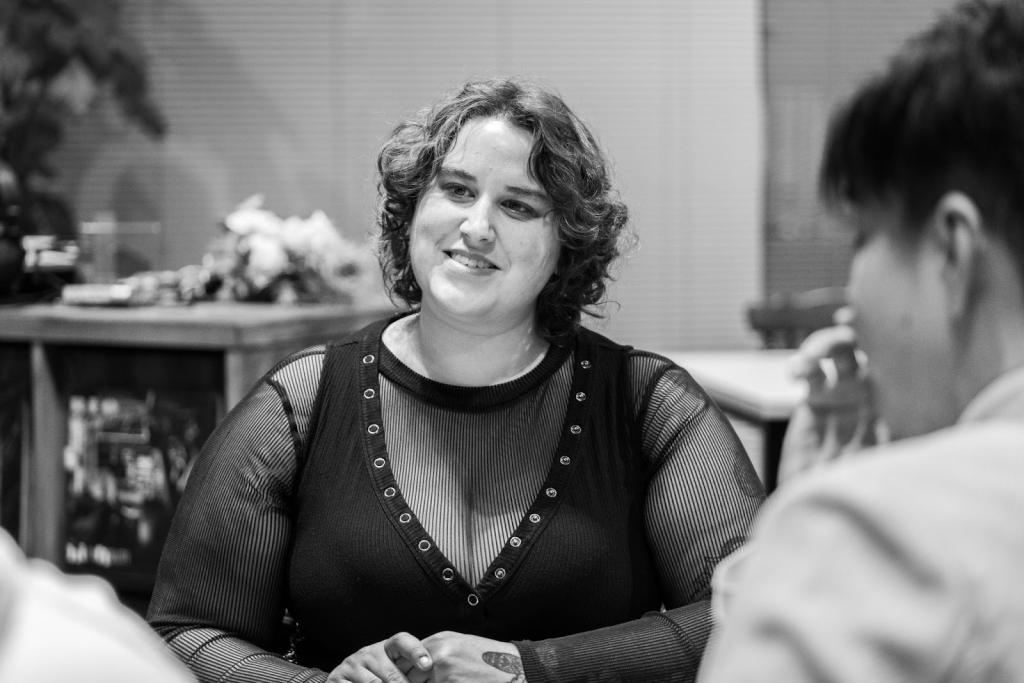
(━━ is overwhelmed with tears and is of no use.)
Saito: (hurriedly)
But a different personality would have worked too, would it have? She could have been more bitter, more evil. But you chose that personality. Why was that?
Tony: (smoothly)
Because she loves you.
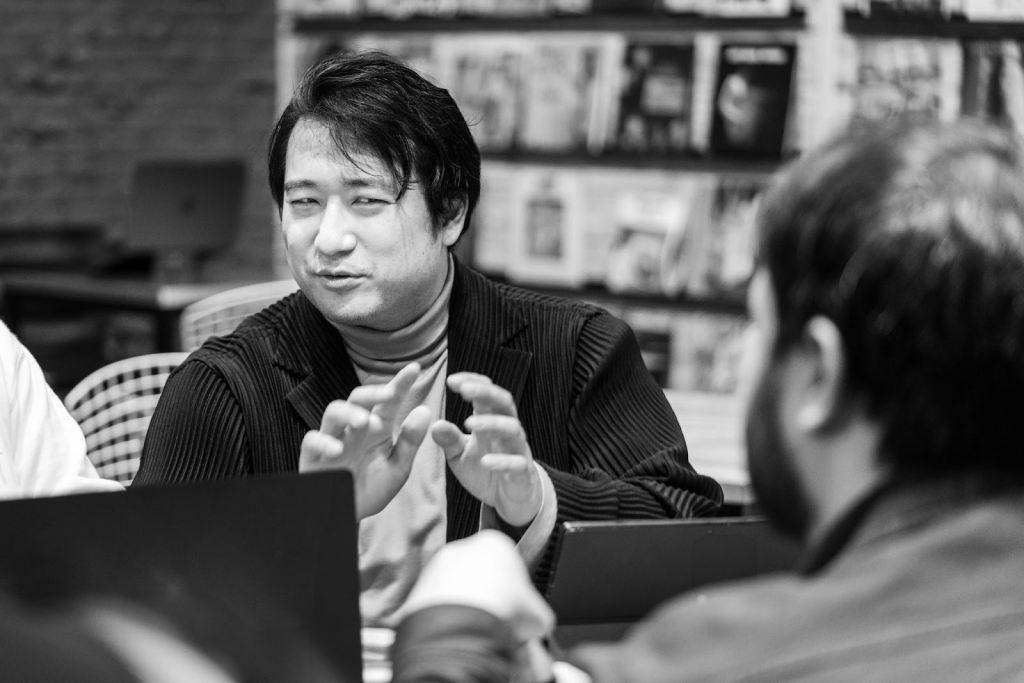
Saito:
Damn, your answers are too crafty! If that’s how it is, then as a member of the media, allow me to give you a hardball question: if that’s how the princess is designed to be, then is it even necessary for her to want to exit the cabin in the first place? She could have been more evil and tempted the player, saying, “Hey, let’s forget about getting out of here. Just stay here forever and play with me.”
But she is positive and optimistic and determined to leave the cabin, and I love that about her!
But you were the ones who chose that personality… Why?!
Abby: (as if an oracle)
Independence.
Because she has the heart to acknowledge the independence of another while also seeking to be with them.
You two each have your own freedom. So you could have also gone your separate ways. Since she is also a god, she could have destroyed you too.
But she didn’t.
Why?
Because you are dear to her.
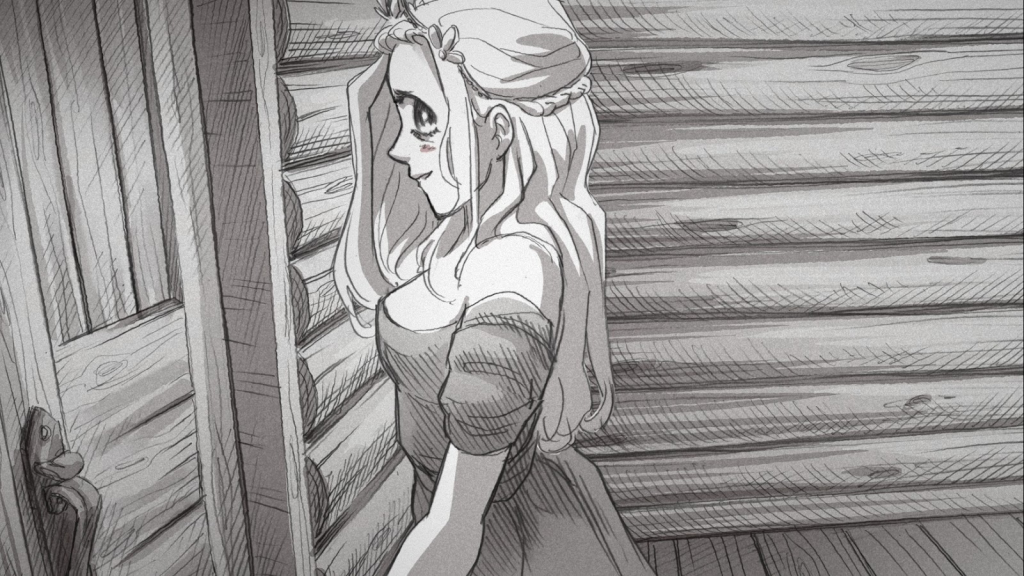
Because you love each other.
This core also hindered her. Because to love each other…you two must be together in that world forever.
But that is just one single possibility. On the other hand, the two of you exiting to the outside together is all possibility.
(Both Saito and ━━ are overwhelmed and rendered speechless.)
Tony: (slightly apologetically)
…Do you two know Plato’s allegory of the cave?
━━ (now in his element) From The Republic?
Abby: (laughing)
Tony has to bring up Plato at least once a day.
Tony: (smiling)
Um, it’s more like once every other day!
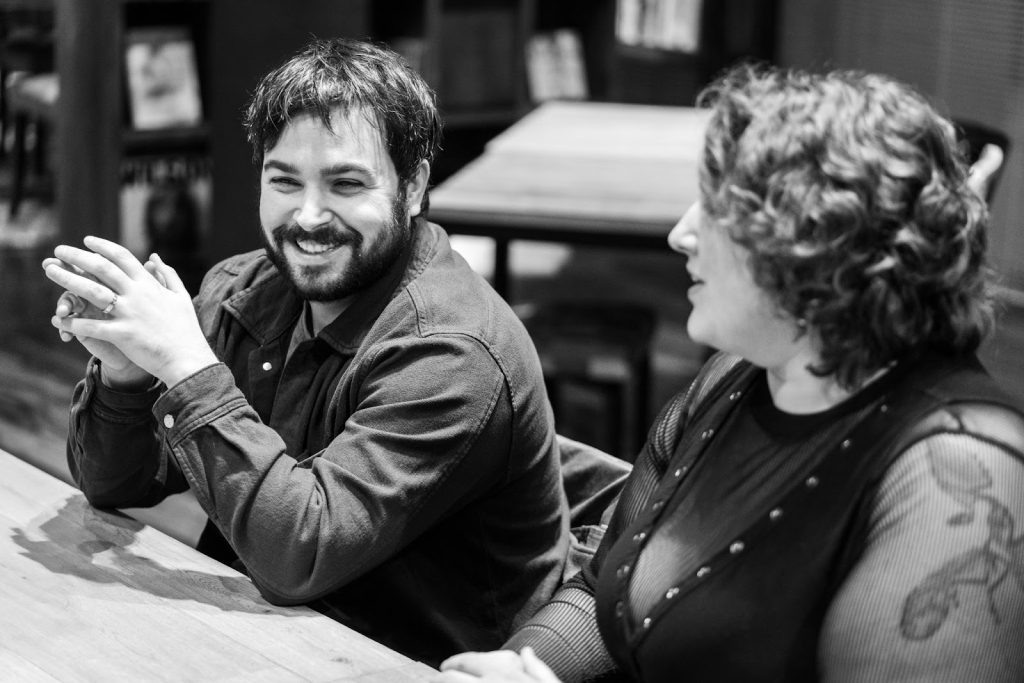
Abby:
Well, it would be helpful.
Tony:
Hmm. In Plato’s best-known work, The Republic, there is this parable…
People are chained inside a cave. Behind them is a flame. They have been there their entire lives, so the only thing they know is their own shadows projected [on the cave wall] by the flame. These shadows seem like reality when they are actually just an approximation of reality.
So here Plato asks the question, “Suppose that one of the chained people were to go out and see the real world, then come back. Would he be able to persuade the others to leave with him?”
https://ja.wikipedia.org/wiki/%E6%B4%9E%E7%AA%9F%E3%81%AE%E6%AF%94%E5%96%A9#/media/%E3%83%95%E3%82%A1%E3%82%A4%E3%83%AB:Plato_-_Allegory_of_the_Cave.png
━━Plato’s “Allegory of the Cave”, drawing by Markus Maurer
This allegory is very helpful in interpreting Slay the Princess because the princess instinctively knows that there is something outside of this world. Something more certain than anything she can see with her eyes.
But she cannot express this. She just has a feeling. So she wants to leave, not alone, but with you.
Saito:
The ending in which you leave the cabin is a true masterpiece. I’ve seen the other endings even in Japanese [games]: coming together, eliminating death… These things are expected.
But simply leaving. That ending moved me. Your hopes and worries of leaving alongside the princess, stripped of all her roles, is written in concise text so wonderfully, so beautifully. I had never seen anything like it before.
Tony:
The process of forming that ending was very interesting.
Initially, there was only the ending in which you exit as a god alongside the Shifting Mound, plus the quote-unquote “ending” for those who clear the game in five minutes in Chapter 1.
Then we return to the cabin in the final chapter. That’s when I got the idea. What if we make an ending where you exit with the princess in her natural form, not as gods?
The first idea that came to me was the protagonist rejecting the princess, because the blade is always there as an option… Meaning, you choose to hand her the blade or slay her.
But when we made these endings, it didn’t…feel right.
I mean, the most important choice in Chapter 1 is whether you pick up the blade or not. If you take it, her personality completely changes.
But we just couldn’t come up with a good ending for what happened after you choose not to pick up the blade in the final cabin [scene].
In other words, we couldn’t give form to the logical consequences of you not picking up the blade. So we realized, “That’s strange. There’s a hole [in the logic] here.”
So we gave it a lot of thought…
“What would happen if you go to her without picking up the blade?”
“What would that even mean?”
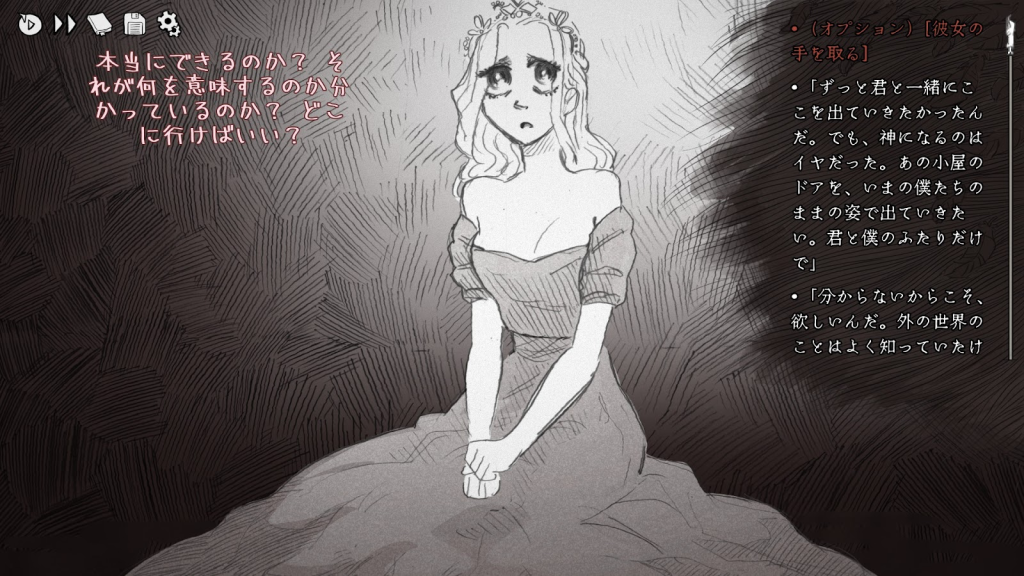
Abby:
That is, how does leaving the cabin with the princess as the protagonist differ from leaving that world in unity with her as a god?
Tony:
Exactly. And we tried over and over to answer that question. But, in the end, we kept coming back to this conclusion…
There is no answer.
This is an unanswerable question. It is an eternal unknown.
So ultimately, was this game trying to convey the unknown? Was it something that told the story of our relationship forged in the midst of facing the unknown?
And though you cannot logically answer why as it is an unanswerable question, that ending made us feel something. A different feeling from the other endings.
So we were convinced that we needed to use this ending in which the two simply leave the cabin. We felt strongly that this ending should be here, like this. Even if we didn’t know the meaning of it.
━━I know exactly the meaning. You two discovered…the Way.
“The Tao literally means a Path. It has been severally translated as the Way, the Absolute, the Law, Nature, Supreme Reason, the Mode. These renderings are not incorrect, for the use of the term by the Taoists differs according to the subject-matter of the inquiry. Laotse himself spoke of it thus: “There is a thing which is all-containing, which was born before the existence of Heaven and Earth. How silent! How solitary! It stands alone and changes not. It revolves without danger to itself and is the mother of the universe. I do not know its name and so call it the Path. With reluctance I call it the Infinite. Infinity is the Fleeting, the Fleeting is the Vanishing, the Vanishing is the Reverting.” The Tao is in the Passage rather than the Path. It is the spirit of Cosmic Change,—the eternal growth which returns upon itself to produce new forms.”
━━The Book of Tea, by Kakuzo Okakura
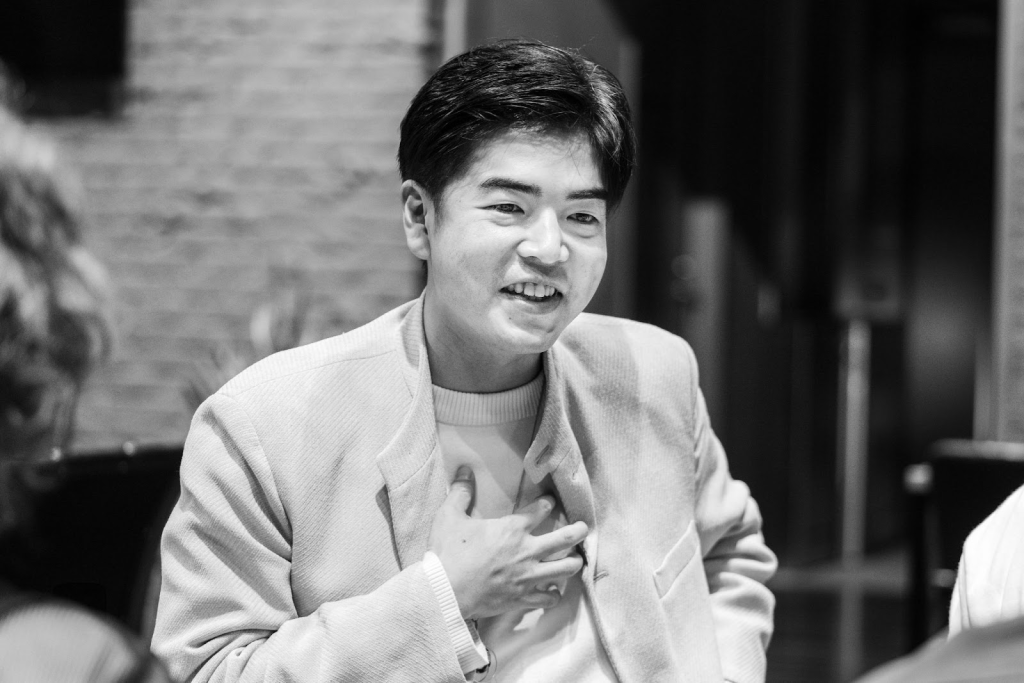
━━(slowly) I’ve been playing your game with hopes and worries about this interview turning out well.
━━For that reason, I got caught in the logical hole that Tony mentioned earlier. No matter how I squirmed, I couldn’t get out. I’d slip back down, and the linchpin of the question just wouldn’t catch.
━━I thought, this won’t do. I need a break. So I stepped away from the game.
━━In doing so, I reflected, reflected, and reflected on that game. I no longer knew what the game was exactly.
━━Exhausted, I returned to my computer and started the game up one last time… And there was that first note clearly written:
━━“This is a love story.”
━━I was knocked off my feet.
━━So here is my last question…
━━When and with what thought did you add that notes?
Tony:
…When did I write that…?
I remember now. I made a draft for an announcement on X saying that we finished the game and were releasing it.
I thought I’d sum up what kind of game it was in one phrase.
And then I finished writing the text.
And it was…really well-written.
I was really…happy.
So I wanted to convey this to people who didn’t look at the X post too. I wanted them to know before they played the game.
Abby:
If I were to comment on that text itself…
The princess knows that you are someone important from the beginning.
That text provides the player with advanced knowledge that you are important to the princess. And it gives you the unconscious understanding that you, the player, care about her in the same way.
So you’re reflecting from the beginning… You two know that this is love from the beginning.
Of course, I think there are players who first meet the princess and fall in love at first sight.
But before starting the game, before you meet her, you know on some level that she is there, which means…
…it’s a fateful encounter, wouldn’t you think?
Tony:
…I know. Your question can be answered in two ways. Let’s start with the long answer…
This game is full of confrontations and contradictions.
We are currently discussing just the “This is a love story” part, but that entire note also contained the message, “Be warned that this is a very scary horror game with gory images.”
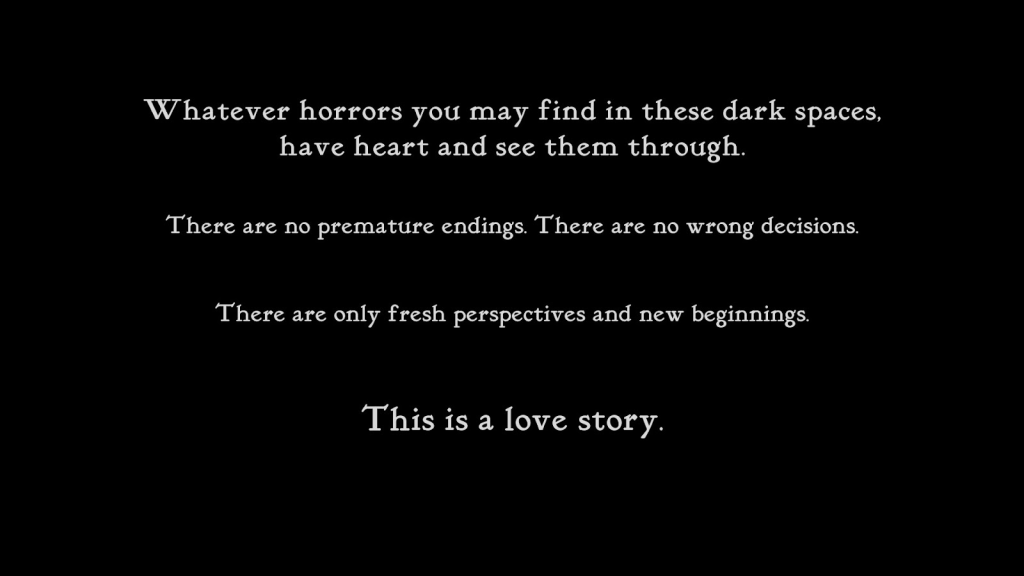
“Whatever horrors you may find in these dark spaces, have heart and see them through. There are no premature endings. There are no wrong decisions. There are only fresh perspectives and new beginnings.”
And yet, the “This is a love story” part takes you by surprise at the end. Fear and love. These two things contradict each other at first glance. Contradiction breeds insecurity. And through this insecurity, we try to remove the player’s armor…
That was the long answer.
And the short, more truthful answer is…
(pauses)
…It’s not logical.
It’s not reason.
The moment I finished writing, I knew.
Abby: (almost whispering)
Like when you wrote the ending where you leave the cabin with her.
Tony:
That’s right… That’s exactly it.
I simply thought, “This is good. Let’s make it into a game!”
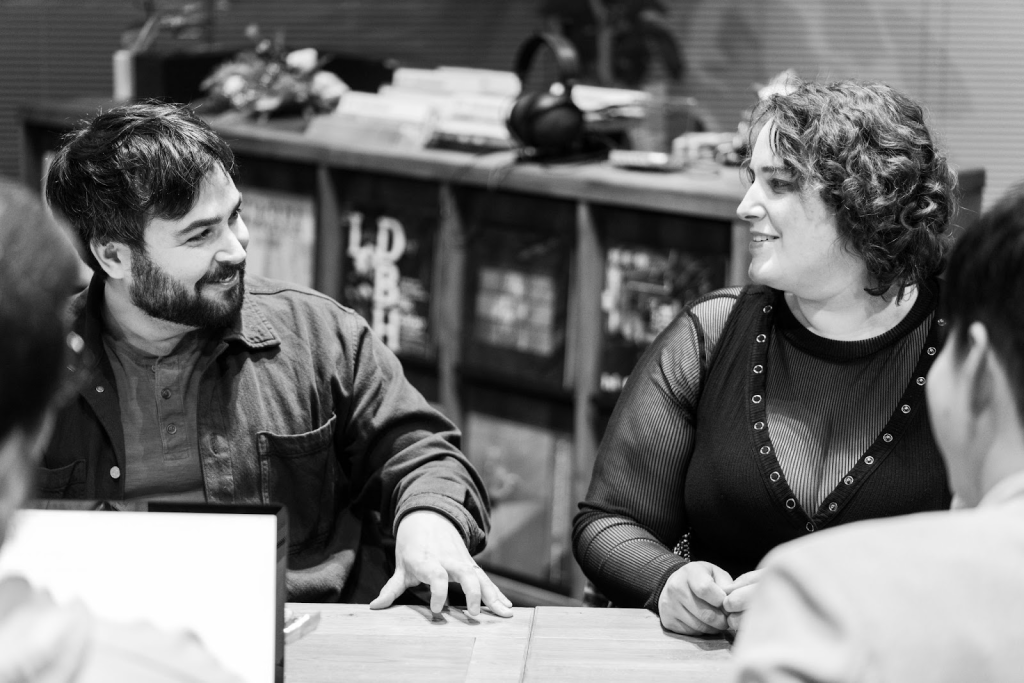
“…love flows out of rightly, seeing reality as it is…”
━━The Awakening of Zen, by Daisetsu Teitaro Suzuki
Having finished the interview, we enjoyed dinner together at a restaurant somewhere in Tokyo serving traditional Buddhist vegetarian cuisine.
Our off-record discussions soared to even greater heights with alcohol in the mix, but, for obvious reasons, the content of our private conversations cannot be detailed here.
But just one last note…
The restaurant was located on the second floor of the building, an elevator carrying us inside. After our meal, the restaurant staff escorted us out through a different entrance from the one we used on arrival. And as we passed through, there was a Japanese garden with maple and gingko trees glowing in the black of night, its path gently leading down to the main streets of Tokyo. We walked along that path in the woods, relying on the light from a lantern.
After completing our descent, we embraced and parted ways.
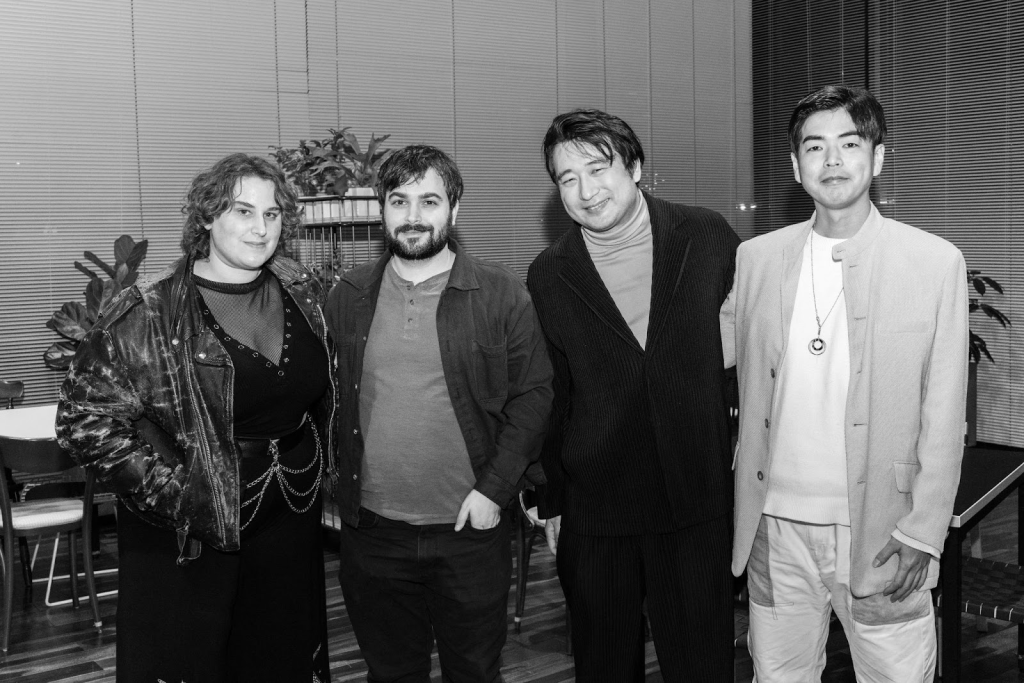
As I made my way home, as I walked outside, those words came to me.
“You’re on a path in the woods.”
How they would have delighted had I told them that this was that same path in those woods. But perhaps I’ll have another opportunity to do so, for after finishing the interview, Saito received a letter from Tony Howard. With his permission, I have included his message as follows, and here is where I shall cease writing.
Hello Daichi,
I’d like to send a note expressing our heartfelt appreciation for yesterday’s interview and dinner, and for inviting us as guests to your country. It is rare to speak to interviewers who genuinely understand our intentions with Slay the Princess, and while the interview was long, the questions were so thoughtful that it felt like it took no time at all to answer them, and was such an engaging conversation we didn’t want it to end. Likewise, we deeply enjoyed the conversation over dinner.
We will treasure those memories. Please pass along our thanks to the other members of your team.
As a final note, we spoke briefly on Buddhist thought on the nature of evil and redemption. I believe it is the destiny of all living things to be redeemed 🙂
Abby and I look forward to our continued friendship,
Tony
Tony, Abby, thank you.
It was a wonderful night.